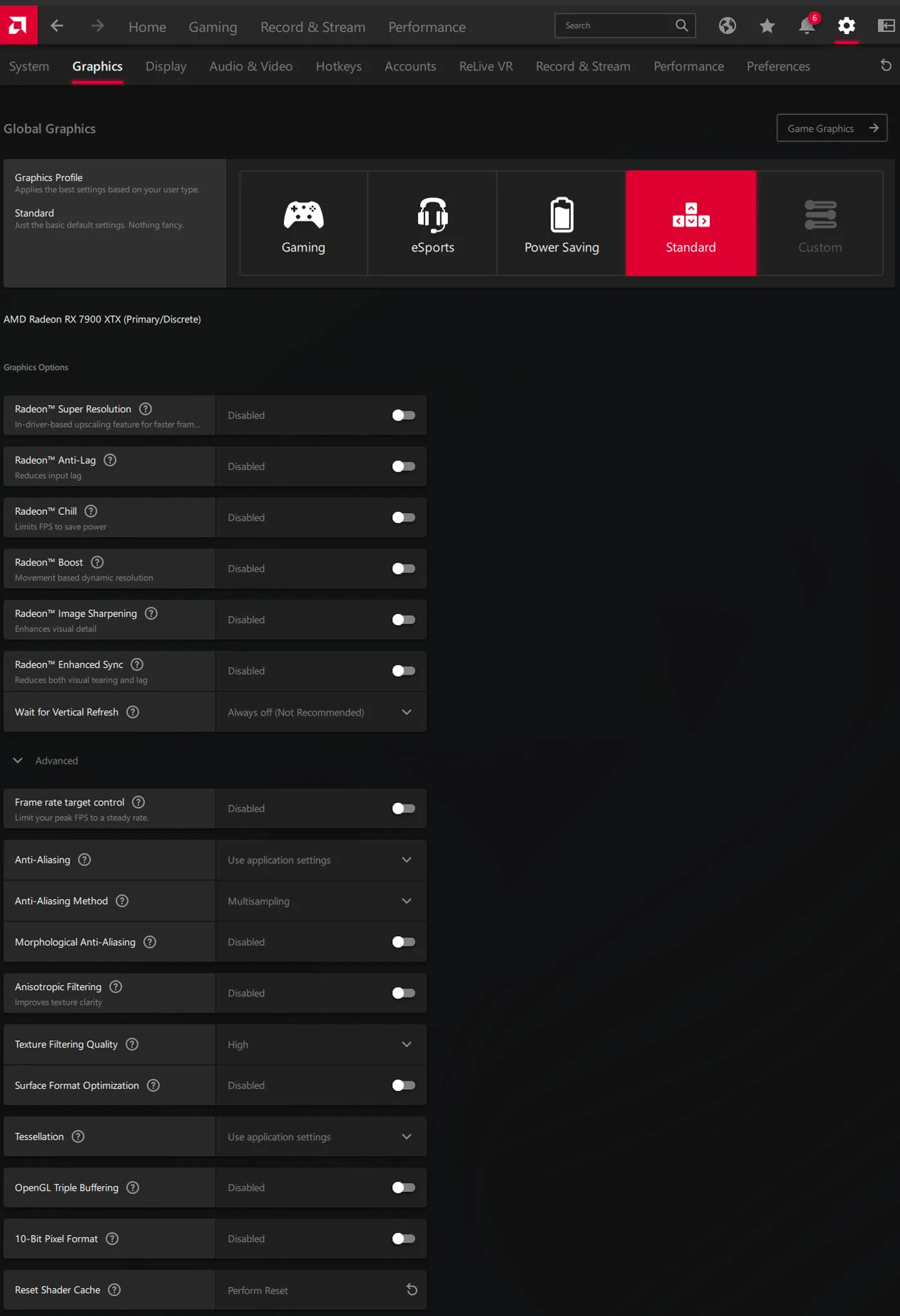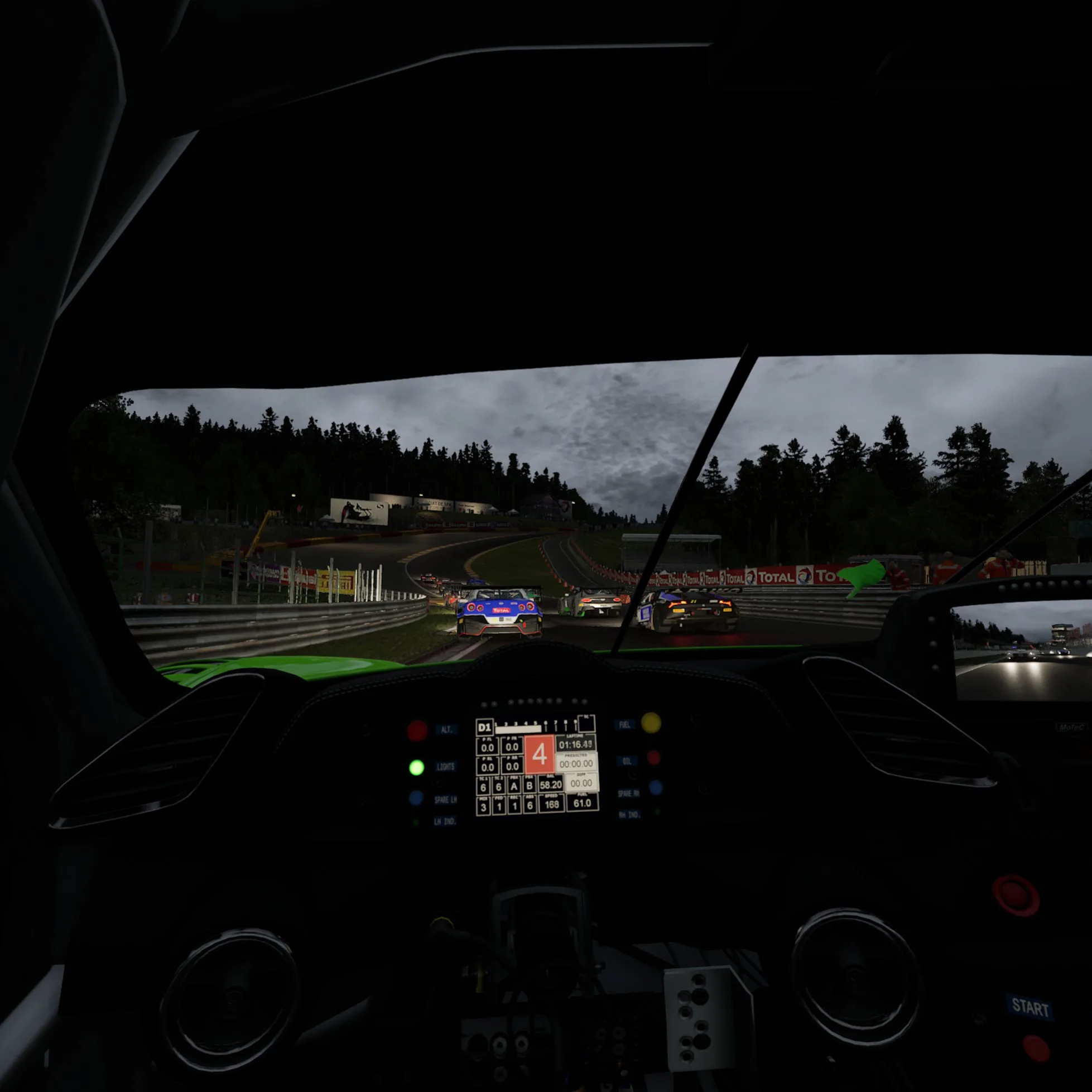The Hellhound RX 7900 XTX takes on the RTX 4080 in more than 50 VR & PC Games , GPGPU & SPEC Workstation Benchmarks
The $999 Hellhound RX 7900 XTX arrived at BTR for evaluation last week from PowerColor. We have been comparing it against Nvidia’s new $1199 RTX 4080 Founders Edition (FE) and $1599 RTX 4090 FE plus five additional top cards. We focus on raw performance by benchmarking 42 PC and 10 VR games, GPGPU, workstation, SPEC, and synthetic benchmarks.
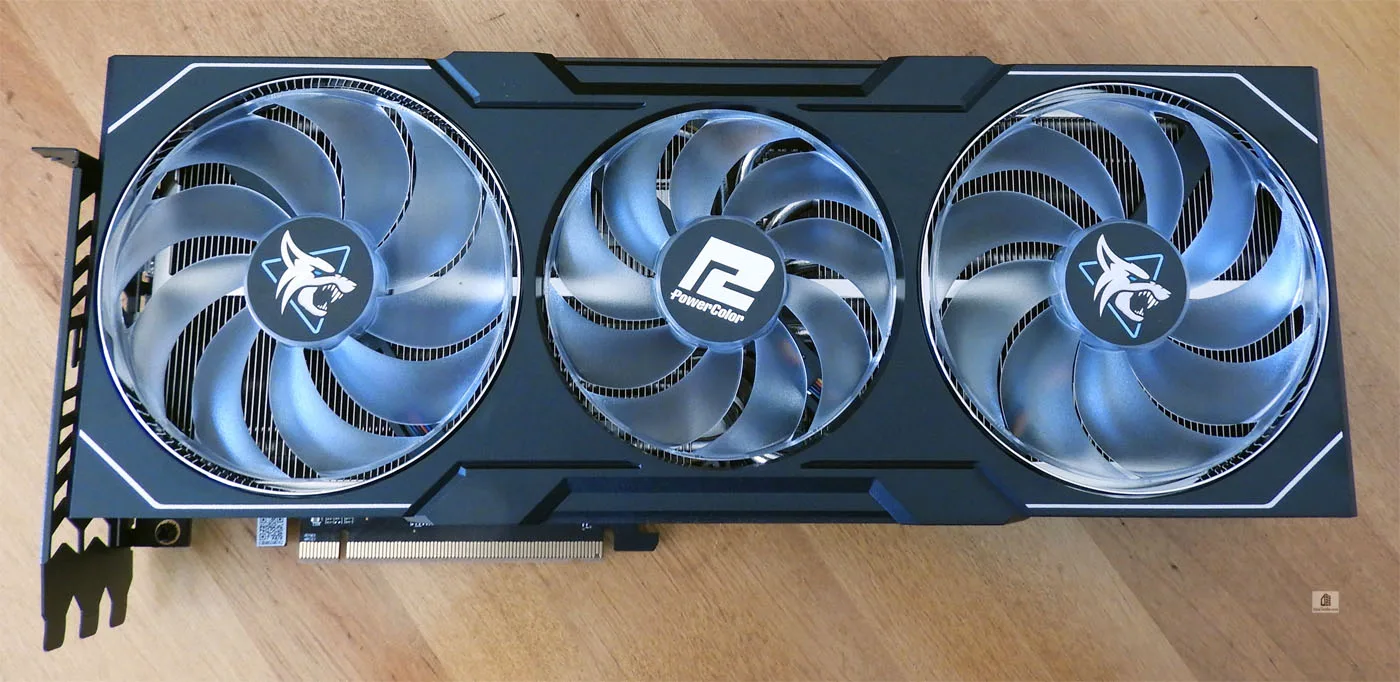
We will also compare the performance of these three new competing cards with the RX 6900 XT and RX 6800 XT reference editions and their competitors, the RTX 3080 Ti and RTX 3080 FE.
Features & Specifications
Although launched at reference $999 XTX pricing, the Hellhound RX 7900 XTX has its factory Game Clock set 30MHz higher than the reference version’s 2300MHz. According to PowerColor specifications, the Hellhound RX 7900 XTX can boost its Game Clock to 2330MHz (2270MHz Silent) with the OC BIOS. The Game Clock is the expected GPU clock while running average high-load gaming scenarios with a regular non-overclocked total graphics usage situation. However, the GPU Boost Clock can reach as high as 2525MHz – 25MHz higher than reference – by using the OC BIOS and we will test this.
Here are the Hellhound RX 7900 XTX features.

Additional Information from PowerColor
- The Hellhound has 2 modes, OC and Silent with a BIOS switch on the side of the card. Even on performance mode it’s said to be considerably quieter than reference board and the silent mode is indeed very quiet.
- The 14 layer high TG PCB board has 12+3+2+2+1 Phase VRM design. Hellhounds are over-spec’d in order to deliver the best stability and overclocking headroom. By having high quality VRMs, it will run cooler and last longer.
- DrMos and high-polymer Caps are used without compromise.
- The cooler features three 9-blade ball bearing fans with 8 heat pipes (8X6?) across a high density heatsink with a copper base. The PCB is shorter than the cooler.
- It uses mute fan technology and the fans stop under 60C.
- The Hellhound RX 7900 XTX includes card stands for supporting it so as to not put extra strain on the PCIe slot.
The RX 7900 XTX is AMD’s brand new RDNA 3 flagship card, and the Hellhound represents one of the best choices for a mildly factory overclocked $999 card by virtue of its high-quality components and carefully selected GPUs coupled with good support and great warranty service.
The Test Bed
We benchmark using FCAT VR and FrameView on Windows 11 Pro Edition 2H22 with Intel’s Core i9-13900KF, and 32GB of T-Force Delta RGB 6400MHz CL40 DDR5 2x16GB memory on an ASUS Prime-A Wi-Fi Z790 motherboard with fast SSD storage. All games and benchmarks are patched to their latest versions, and we use recent drivers.
First, let’s take a closer look at the new PowerColor Hellhound RX 7900 XTX.
A Closer Look at the PowerColor Hellhound RX 7900 XTX
Although the Hellhound RX 7900 XTX advertises itself as a premium 24GB card which features ray tracing, Radeon Boost, and Anti-Lag, the cover of the box uses almost no text in favor of stylized imagery.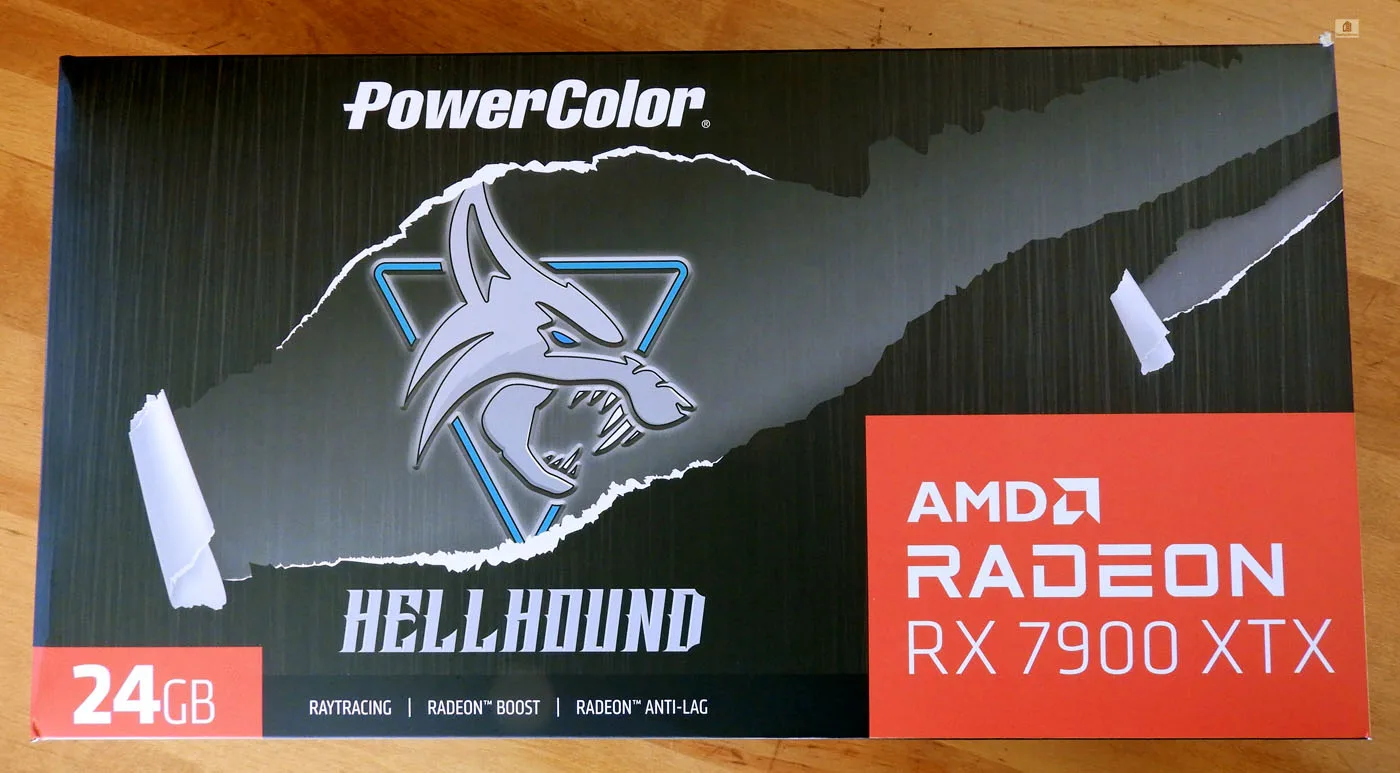
The back of the box touts key features which include ray tracing, Anti-Lag, DisplayPort 2.1, RDNA 3, FidelityFX, Infinity Cache, streaming aids, and Boost, as well as states its 800W power and system requirements. There is no mention of VR Ready Premium. Also highlighted are PowerColor’s custom cooling solution, Dual-BIOSes, fan improvements, and output LEDs. The default LED color is an eye-pleasing amethyst.
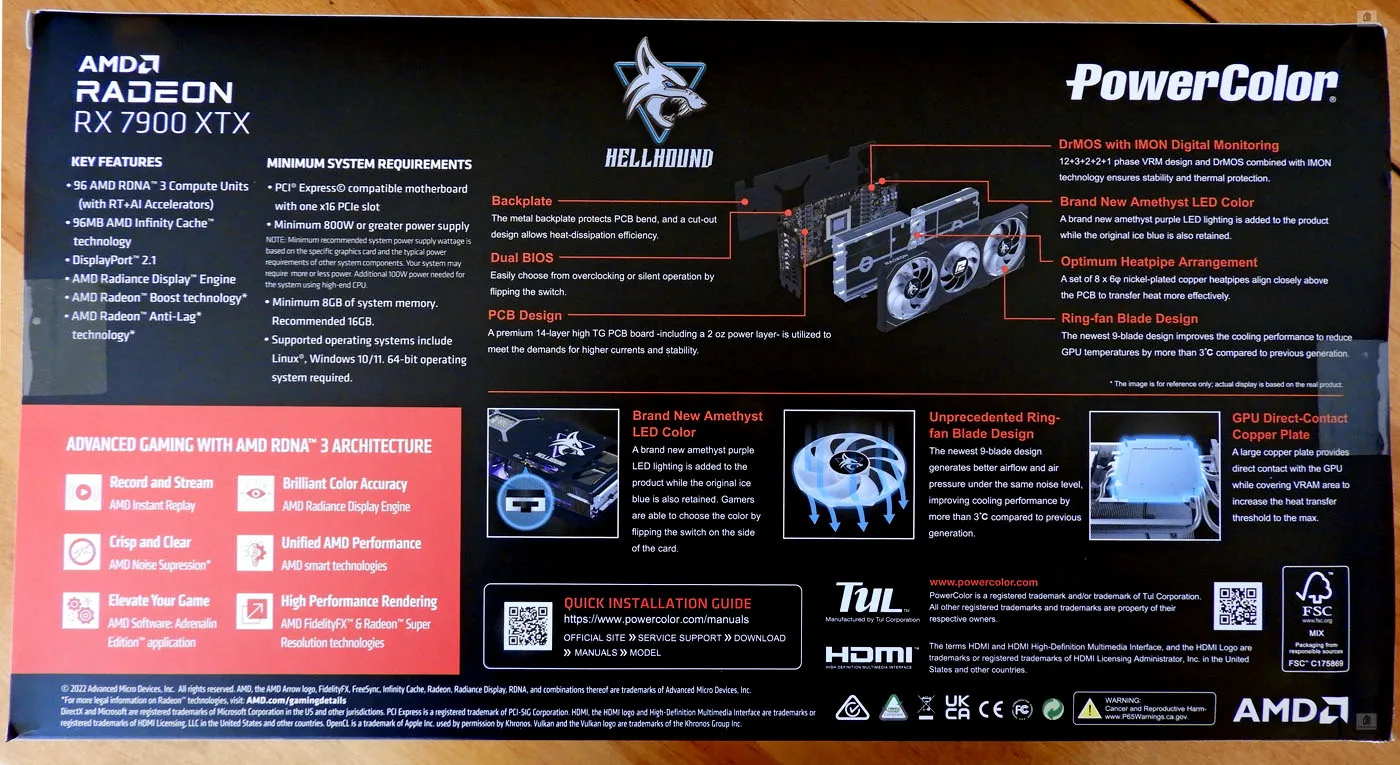
We open the box and note there are parts for a card stand.
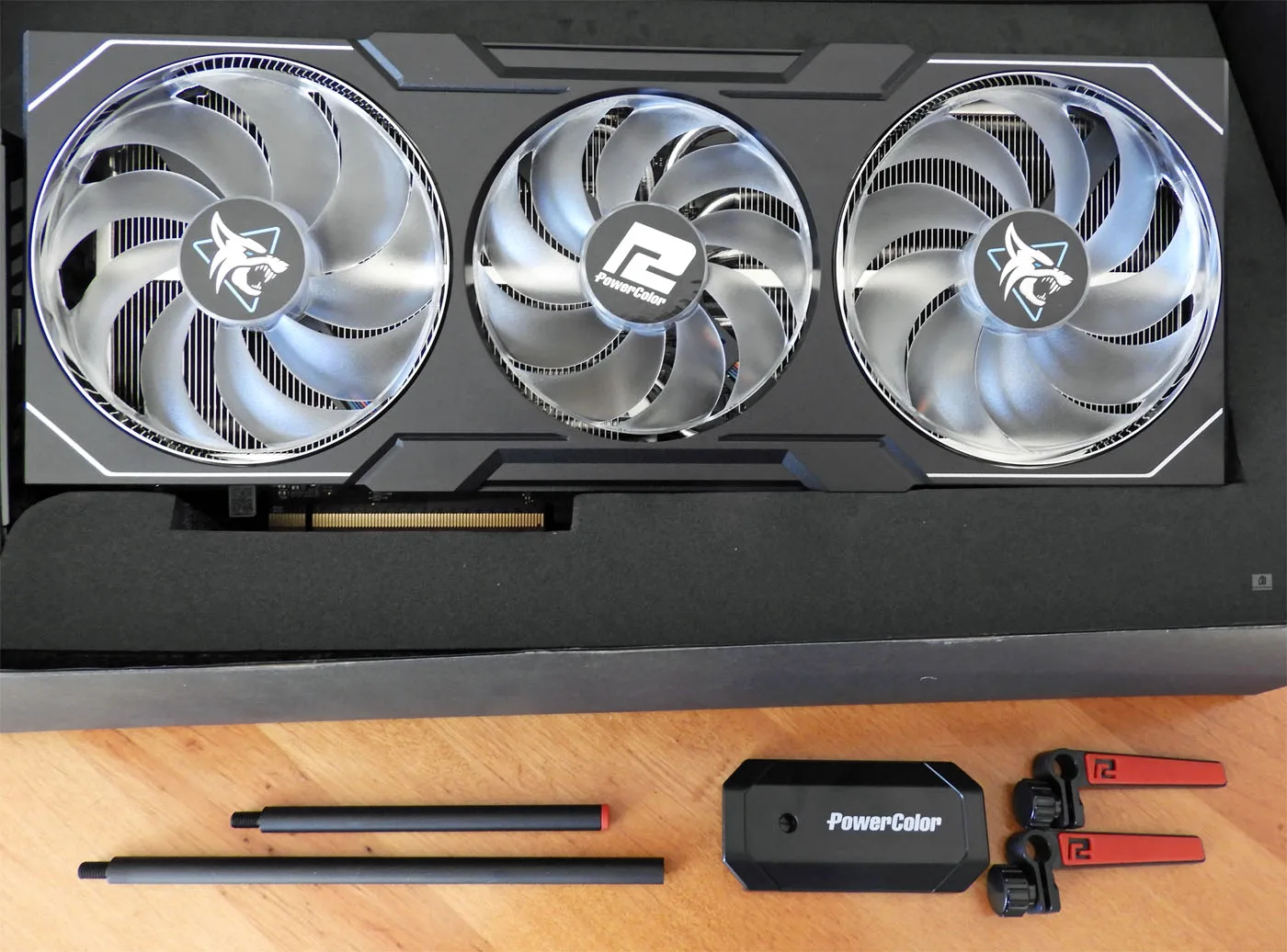
The complete package contents except for the anti-static bag are pictured above together with the card holder parts. 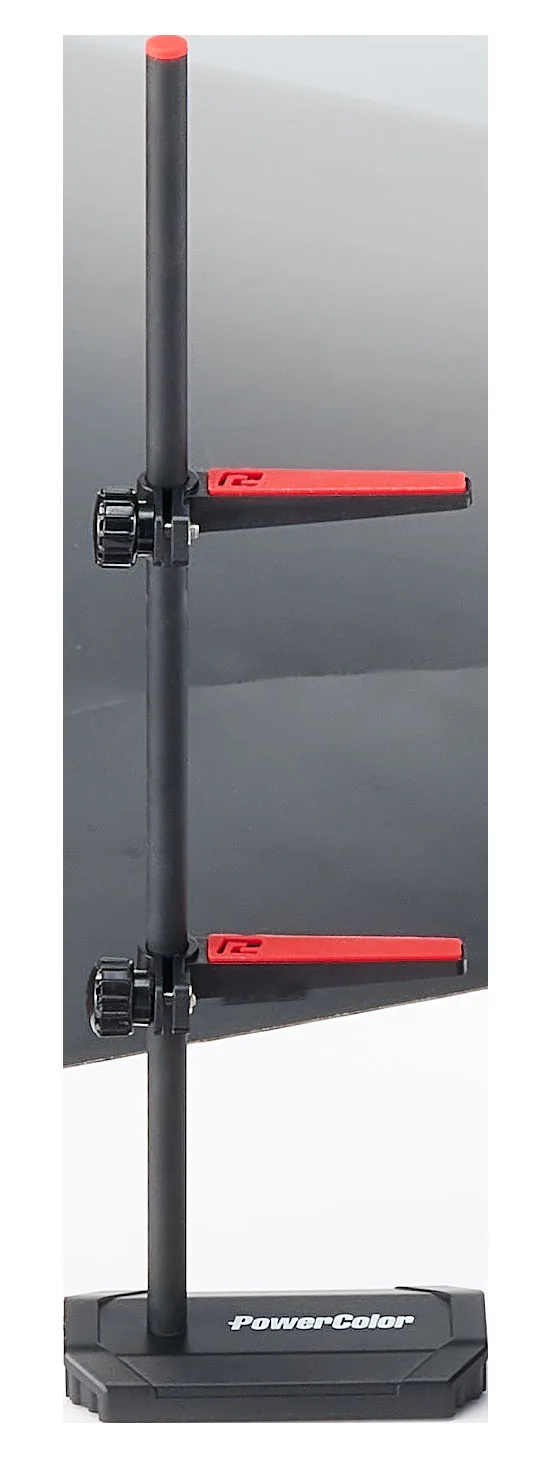 Above the stand is fully assembled. Although the Hellhound is relatively heavy, it is not 4090-heavy, and we didn’t feel a need for it.
Above the stand is fully assembled. Although the Hellhound is relatively heavy, it is not 4090-heavy, and we didn’t feel a need for it.

The Hellhound RX 7900 XTX is a large tri-fan card in a three slot design which is quite handsome with PowerColor’s neutral colors and even more striking with the LED on.
Turning it over we see a sturdy backplate featuring the Hellhound logo which also lights up with amethyst being the default color. 
Looking at either long edge, we see the entire PCB is covered by heatpipes and heatsink fins. Additional power is provided by the PSU’s 2 x 8-pin Molex cables to the card connectors. There is also a switch to choose between the default overclock (OC) BIOS and the Silent BIOS. We didn’t bother using the Silent BIOS as the card is really quiet anyway, but it is good to have in case a flash goes bad.


The card should perhaps be locked down with two thumbscrews instead of one because it is heavy or the stand can be used.
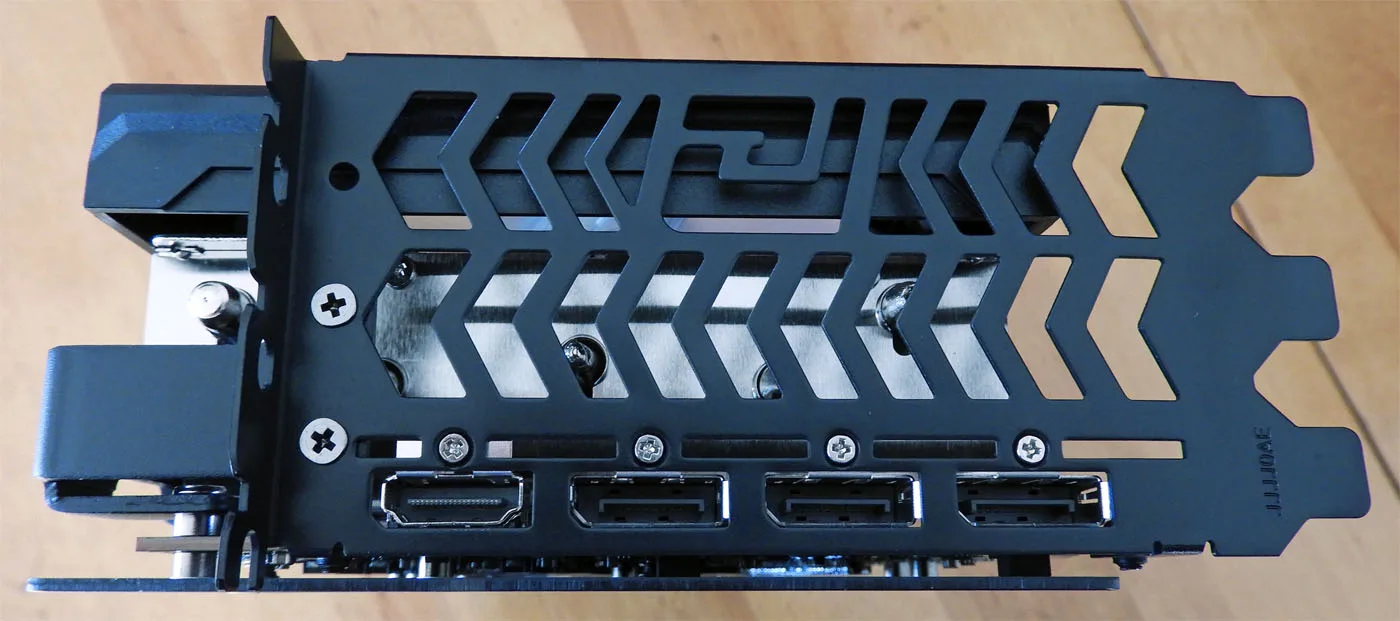
The Hellhound’s IO panel connectors include 3 DisplayPorts and 1 HDMI connection.
Below is the other end which is very plain.
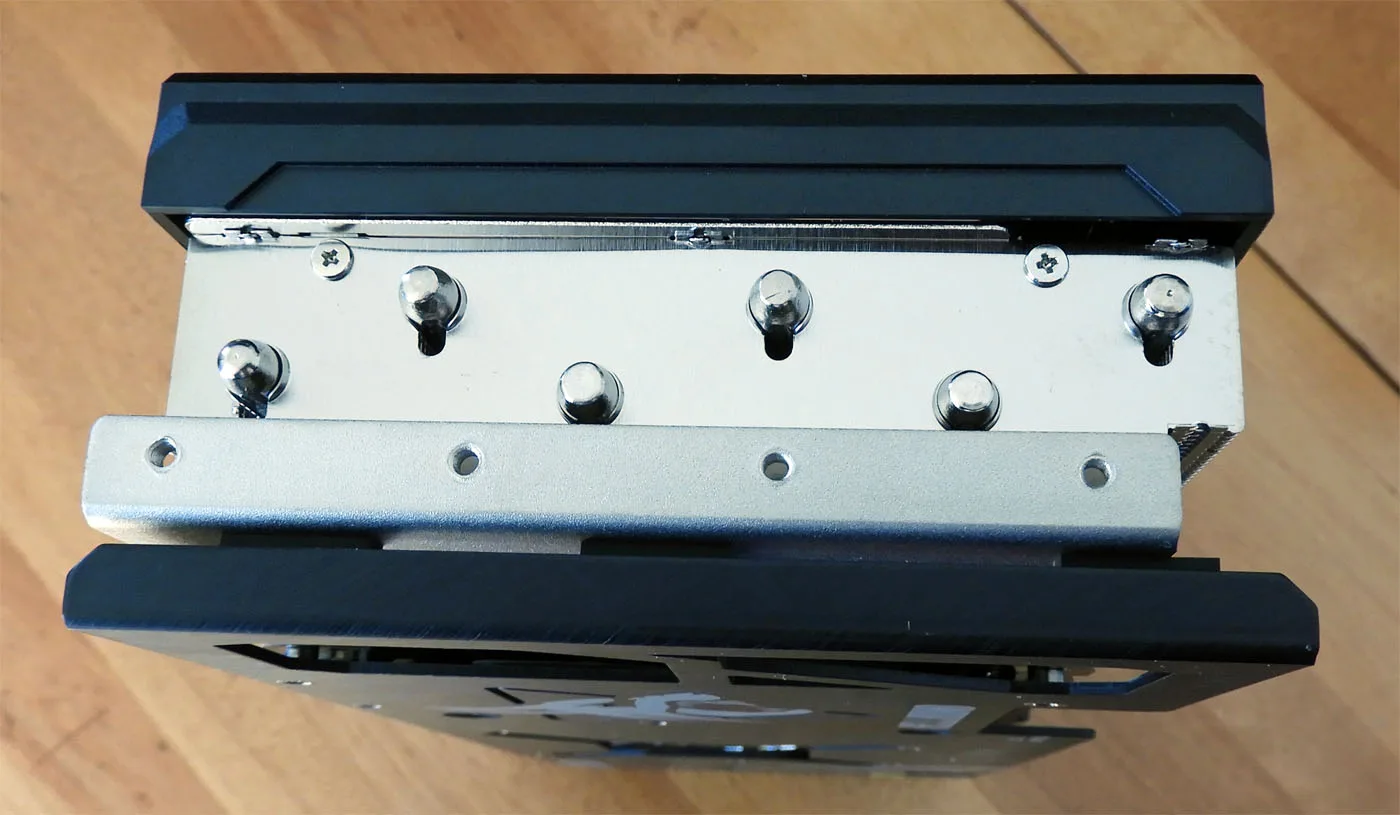
The Hellhound RX 7900 XTX looks great inside a case.
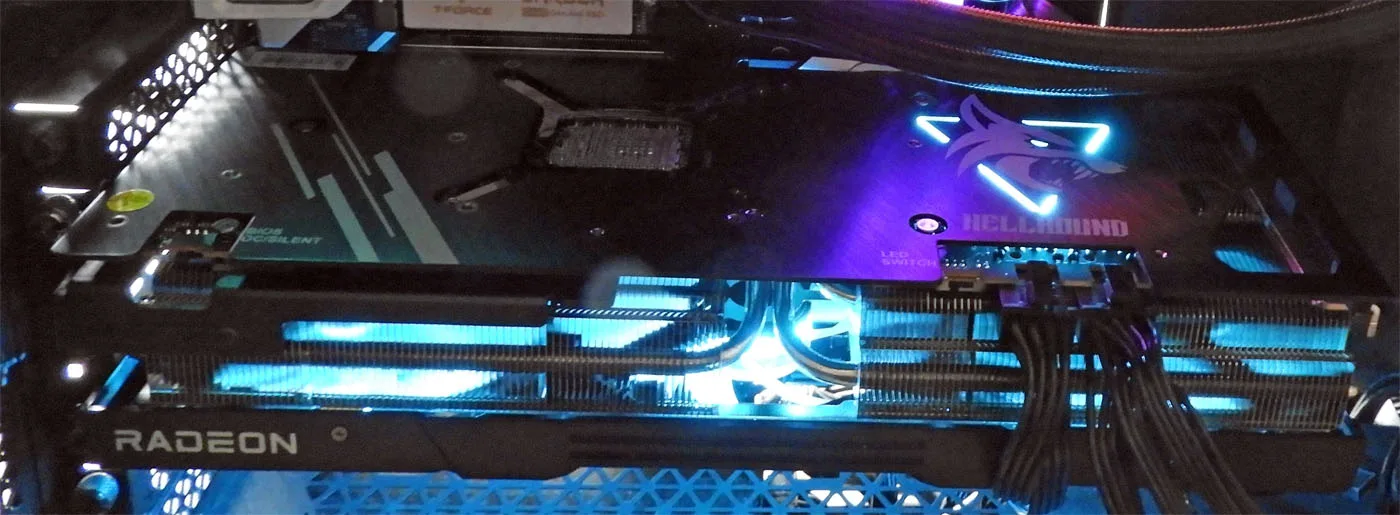
The specifications look good and the card itself looks solid. Now let’s check out its performance after we look over our test configuration and more on the next page.
Test Configuration
Test Configuration – Hardware
- Intel Core i9-13900KF (HyperThreading and Turbo boost at stock settings)
- ASUS Prime-A Z790 LGA1700 motherboard (Intel Z790 chipset, latest BIOS, PCIe 5.0, DDR5)
- T-Force Delta RGB PC5-51200 6400MHz DDR5 CL40 2x16GB kit, supplied by TeamGroup
- Valve Index, 90Hz / 100% SteamVR Render Resolution
- Hellhound RX 7900 XTX, 24GB, factory clocks, supplied by PowerColor
- RTX 4080 16GB Founders Edition, stock clocks, supplied by Nvidia
- RTX 4090 24 GB Founders Edition, stock clocks, supplied by Nvidia
- Gigabyte RX 6900 XT GAMING OC, 16GB, factory clocks
- RX 6800 XT Reference 16GB, factory clocks, supplied by AMD
- RTX 3080 Ti 12GB Founders Edition, stock clocks, supplied by Nvidia
- RTX 3080 10 GB Founders Edition, stock clocks, supplied by Nvidia
- 2 x 2TB T-Force Cardea Ceramic C440 (5,000/4,400MB/s) PCIe Gen 4 x4 NVMe SSDs (one for AMD/one for Nvidia)
- T-Force M200 4TB USB 3.2 Gen2x2 Type-C external SSD (2,000x2000B/s), supplied by TeamGroup
- Super Flower LedEx, 1200W Platinum 80+ power supply unit
- MSI MAG Series CORELIQUID 360R (AIO) 360mm liquid CPU cooler
- Corsair 5000D ATX mid-tower (plus 1 x 140mm fan & 2 x 120mm Noctua fans)
- BenQ EW3270U 32? 4K HDR 60Hz
- LG C1 48″ 4K OLED HDR 120Hz display
Test Configuration – Software
- GeForce 526.98 drivers for the RTX 4090/4080 and 527.27 for the RTX 3080/3080 Ti. Adrenalin 22.11.2 for the RX 6800 XT and 6900 XT, and press drivers for the RTX 7900 XTX.
- High Quality, prefer maximum performance, single display, set in the Nvidia control panel.
- High Quality textures, all optimizations off in the Adrenalin control panel
- VSync is off in the control panel and disabled for each game
- AA enabled as noted in games; all in-game settings are Ultra Preset or highest with 16xAF always applied – no upscaling is used
- Highest quality sound (stereo) used in all games
- All games have been patched to their latest versions
- VR charts use frametimes in ms where lower is better, but we also compare “unconstrained framerates” which shows what a video card could deliver (headroom; higher is better)
- Windows 11 Pro edition; 22H2 recent clean install for GeForce and Radeon cards using separate but identical NVMe SSDs.
- Latest DirectX
- SteamVR latest beta
Games
Vulkan
- Sniper Elite
- DOOM Eternal
- Red Dead Redemption 2
- World War Z
- Strange Brigade
- Rainbow Six: Siege
DX12
- A Plague Tale: Requiem
- Spiderman: Remastered
- F1 2022
- Ghostwire: Tokyo
- Elden Ring
- God of War
- Dying Light 2
- Forza Horizon 5
- Call of Duty: Vanguard
- Marvel’s Guardians of the Galaxy
- Far Cry 6
- DEATHLOOP
- Chernobylite
- Resident Evil Village
- Metro Exodus Enhanced Edition
- Hitman 3
- Godfall
- DiRT 5
- Assassin’s Creed Valhalla
- Cyberpunk 2077
- Watch Dogs: Legions
- Horizon Zero Dawn
- Death Stranding
- Borderlands 3
- Tom Clancy’s The Division 2
- Civilization VI – Gathering Storm Expansion
- Battlefield V
- Shadow of the Tomb Raider
DX11
- Overwatch 2
- Total War: Warhammer III
- Days Gone
- Crysis Remastered
- Destiny 2 Shadowkeep
- Total War: Three Kingdoms
- Grand Theft Auto V
VR Games
- Assetto Corsa: Competizione
- Elite Dangerous
- F1 2022
- Kayak Mirage
- Moss: Book II
- No Man’s Sky
- Project CARS 2
- Skyrim
- Sniper Elite
- The Walking Dead: Saints & Sinners
Synthetic
- Time Spy & Time Spy Extreme (DX12)
- 3DMark FireStrike – Ultra & Extreme
- Superposition
- VRMark Blue Room
- AIDA64 GPGPU benchmarks
- Blender 3.3.0 benchmark
- Geekbench
- Sandra 2020 GPGPU Benchmarks
- SPECworkstation3
- SPECviewperfect 2020
- FCAT VR benching tool
- OpenVR Benchmark tool
Adrenalin Control Panel settings
Here are the Adrenalin Control Panel settings.
NVIDIA Control Panel settings
Here are the NVIDIA Control Panel settings.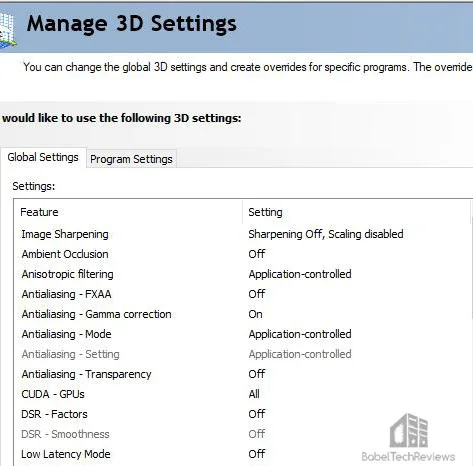


Overclocking, temperatures and noise
We spent little time overclocking the Hellhound RX 7900 XTX for this review as we encountered some unexpected results that require further investigation. The card is very quiet and its fans never spin up even under a heavy load so as to be irritating or even noticeable. It’s quieter than the Gigabyte 6900 XT or the RTX 3080 Ti.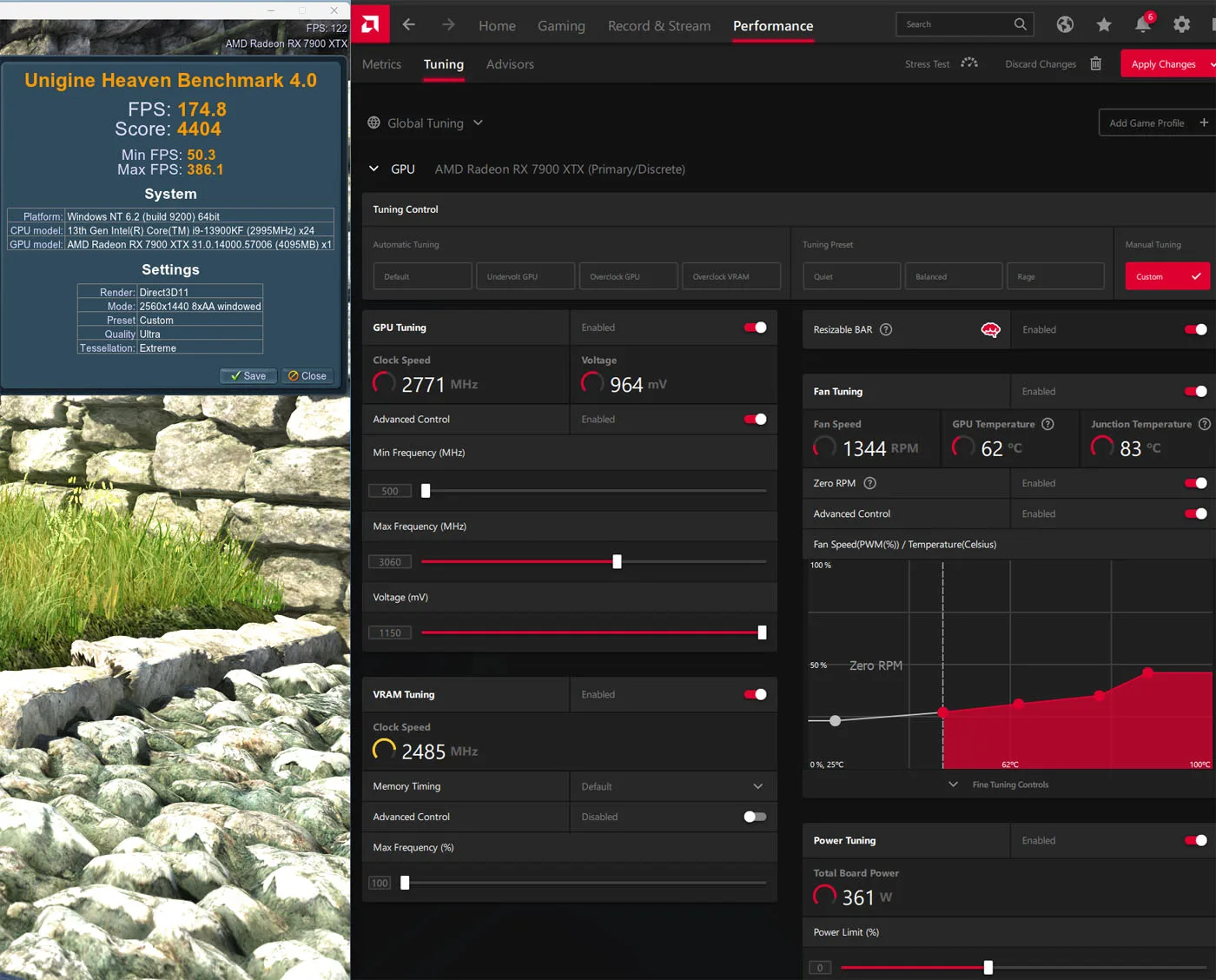
The Hellhound RX 7900 XTX is factory clocked 30MHz higher than the reference version at 2330MHz using the OC BIOS. According to its specifications, the Hellhound boost can clock up to 2565MHz out of the box. From our benching, we generally see it boosting even higher and it generally settles in above 2750MHz with peaks above 2780MHz.
The Hellhound temperatures stay in the low to mid-60s C with the fans quietly running well below 50% even using the OC BIOS under a full gaming load. It is an exceptionally well-cooled and quiet card.
Let’s head to the performance charts to compare the performance of the Hellhound RX 7900 XTX with six other cards.
The Hellhound RX 7900 XTX vs. the RTX 4080 FE and 5 other cards benchmarked with 42 games
Here are the performance results of 42 games and 3 synthetic tests. The highest settings are used and are listed on the charts. The benches were run at 2560×1440 and 3840×2160. Click on each chart to open in a pop-up for best viewing. Gaming results show average framerates in bold text, and higher is better. Minimum framerates are next to the averages in italics and in a slightly smaller font which represent a game’s average 1% lows (99th percentiles).
The first set of charts show the seven main competing cards. Column two represents the $999 Hellhound RX 7900 XTX performance in between the $1599 RTX 4090 FE in column one and the RTX 4080 FE, its $1199 primary competitor, in the third column. The RTX 3080 Ti results are in the fourth column next to Gigabyte RX 6900 XT OC version performance results in the fifth column, followed up by the RTX 3080 in the sixth and the RX 6800 XT in the seventh column.
“Wins” between the RX 7900 XTX and the RTX 4080 are denoted by yellow text. If there is a tie, both values are in yellow.

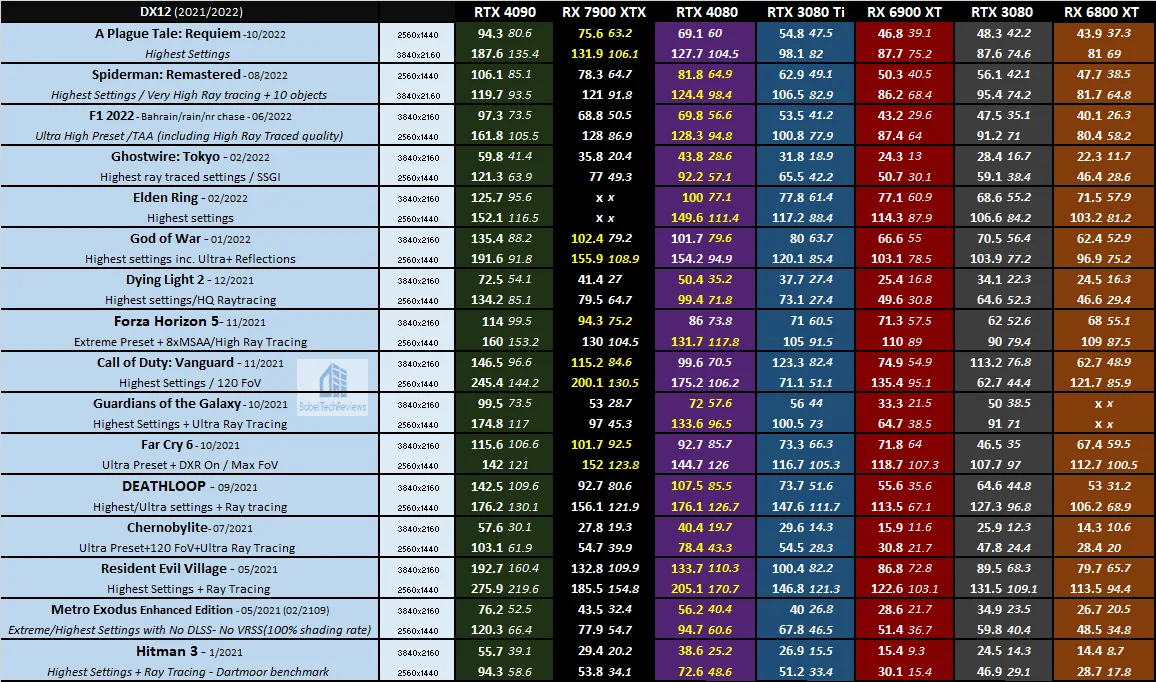
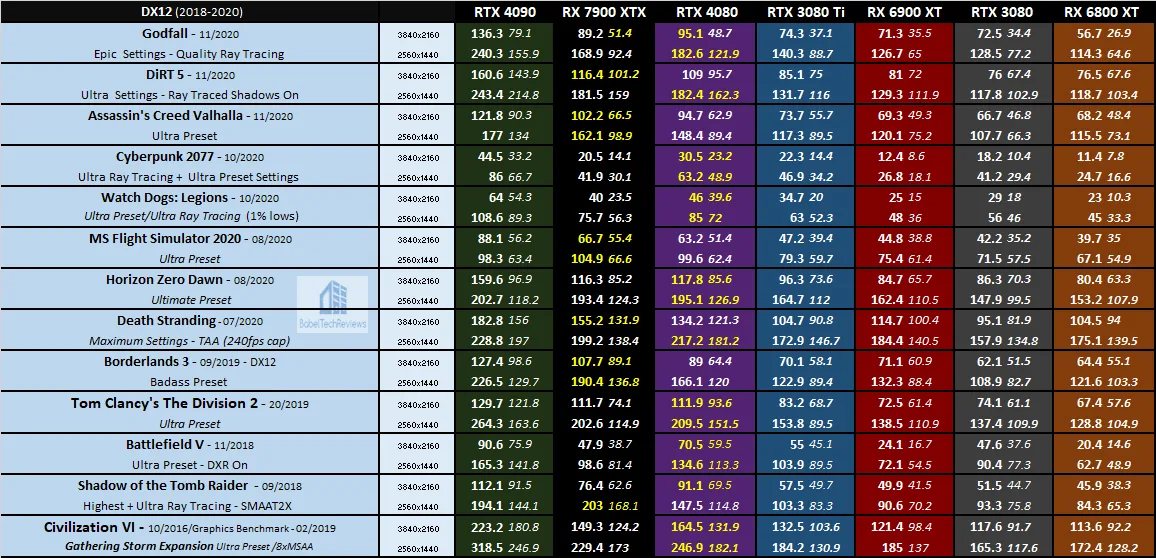

Playing with the RX 7900 XTX, Elden Ring locked up the PC even after verifying files and reinstalling Adrenaline drivers and it appears a driver issue prevented ray traced Guardians of the Galaxy running on the RX 6800 XT.
The Hellhound RX 7900 XTX and the RTX 4080 and RTX 4090 are cards that are primarily suited for 4K and high-FPS 1440P gaming and they stand out from the other four cards. The RX 7900 XTX trades blows with the RTX 4080 in rasterized games – they are equivalent cards if ray tracing is not considered.
Although RX 7900 XTX ray tracing has greatly improved over the RX 6900 XT and RX 6800 XT, it now appears to perform similarly to the RTX 3080 and RTX 3080 Ti but far behind the RTX 4080. FSR 2.0, although still not on the same image quality level as Nvidia’s DLSS 2, will almost double framerates for a very minor IQ hit and will make most of the games quite playable at Ultra/4K in this 52 game benching suite. Gamers who are not so impressed with ray tracing or who are not picky about image quality perfection may well prefer to save $200 on a $1000 Hellhound RX 7900 XTX over buying a $1200 RTX 4080.
Let’s look at synthetic benches.
Synthetic benches
We hold synthetic benches to be meaningless for predicting real world gaming performance versus competing cards with different architectures although they have other practical uses like overclocking and ranking. The RX 7900 XTX performs better in the synthetic tests than in gaming.
Let’s see how the Hellhound performs in ten popular VR (Virtual Reality) games next.
10 VR Games
For this review, we benchmarked the Valve Index using FCAT VR and set the SteamVR render resolution to 100% (2016×2240) which uses a factor of 1.4X (the native resolution is 1440×1600) to compensate for lens distortion and to increase clarity. We are going to compare the performance of the RX 7900 XTX with the RX 4080 and versus the RX 4090 at each game’s Ultra/Highest settings.
Unfortunately, FCAT VR still doesn’t work with MS Flight Simulator 2020 or with Star Wars Squadrons. Here are the ten VR games we tested.
VR Games
- Assetto Corsa: Competizione
- Elite Dangerous
- F1 2022
- Kayak Mirage
- Moss: Book II
- No Man’s Sky
- Project CARS 2
- Skyrim
- Sniper Elite
- The Walking Dead: Saints & Sinners
Synthetic
- Time Spy & Time Spy Extreme (DX12)
- 3DMark FireStrike – Ultra & Extreme
- Superposition
- VRMark Blue Room
IMPORTANT: BTR’s charts use frametimes in ms where lower is better, but we also compare “unconstrained framerates” which shows what a video card could deliver (headroom) if it wasn’t locked to either 90 FPS or to 45 FPS by the HMD. In the case of unconstrained FPS, measuring just one important performance metric, faster is better.
Let’s individually look at our 10 sim-heavy VR games’ performance using FCAT VR.
First up, Assetto Corsa: Competizione.
Assetto Corsa: Competizione (ACC)
BTR’s sim/racing editor, Sean Kaldahl created the replay benchmark run that we use for both the pancake game and the VR game. It is run at night with 20 cars, lots of geometry, and the lighting effects of the headlights, tail lights, and everything around the track looks spectacular.
Here are the ACC FCAT VR frametimes using VR Ultra using the Hellhound RX 7900 XTX, the RTX 4080 FE, and the RTX 4090 FE.

Here are the details are reported by FCAT-VR:
The RX 7900 XTX managed 85.77 unconstrained FPS with 6339 (50%) synthesized frames with no dropped frames nor Warp misses.
The RTX 4080 delivered 118.42 unconstrained FPS with 207 (2%) synthesized frames with 1 dropped frame and 1 Warp miss.
The RTX 4090 achieved 164.03 unconstrained FPS together with 1 synthetic frame but with no dropped frames nor Warp misses.
The ACC racing experience is best with the RTX 4090 although the RTX 4080 delivers a nearly constant 90 FPS on the Epic VR preset unlike the RX 7900 XTX which requires one-half of its frames to be synthesized.
Next, we check out Elite Dangerous.
Elite Dangerous (ED)
Elite Dangerous is a popular space sim built using the COBRA engine. It is hard to find a repeatable benchmark outside of the training missions.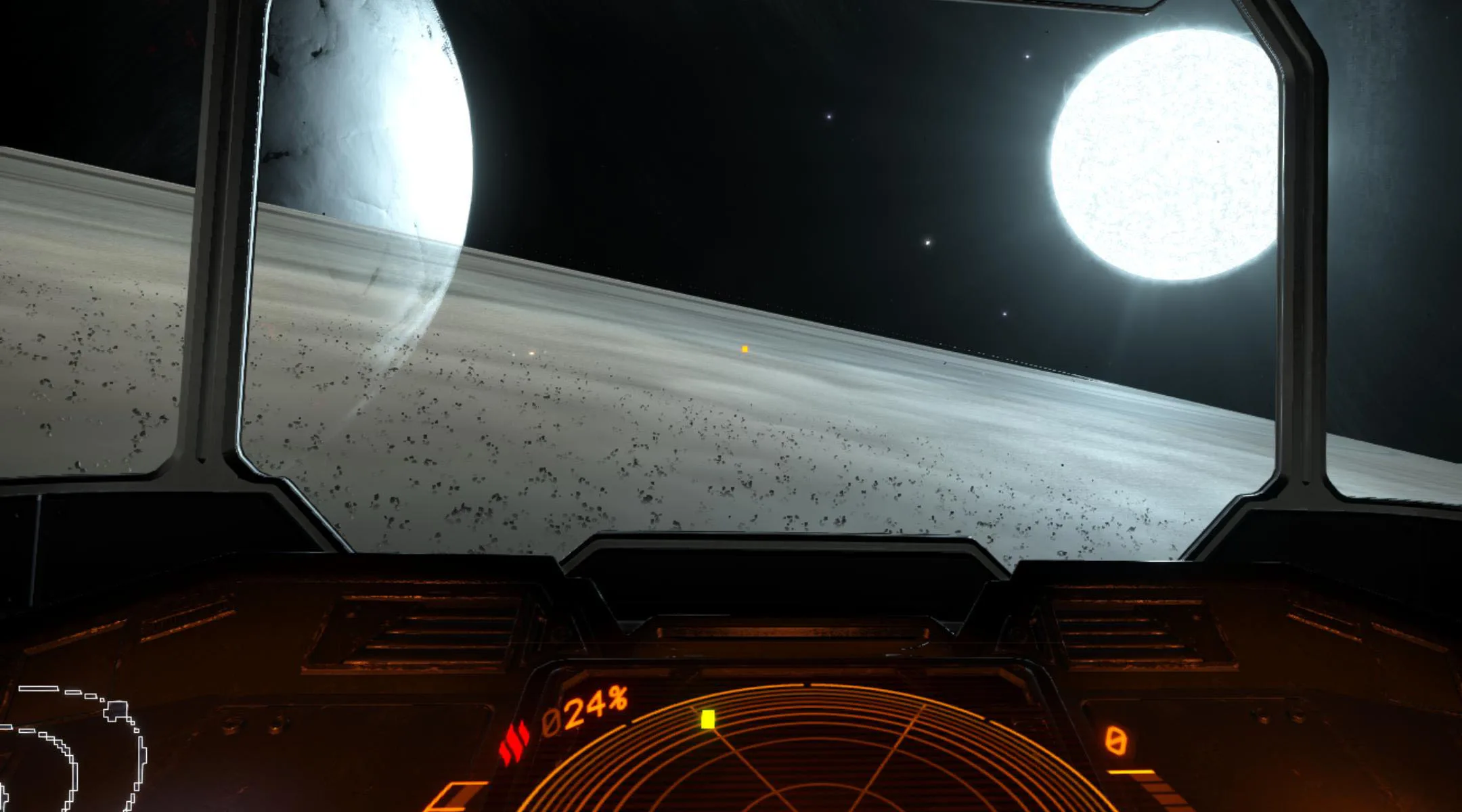
A player will probably spend a lot of time piloting his space cruiser while completing a multitude of tasks as well as visiting space stations and orbiting a multitude of different planets. Elite Dangerous is also co-op and multiplayer with a dedicated following of players.
We picked the Ultra Preset and we set the Field of View to its maximum.
Here are the frametimes.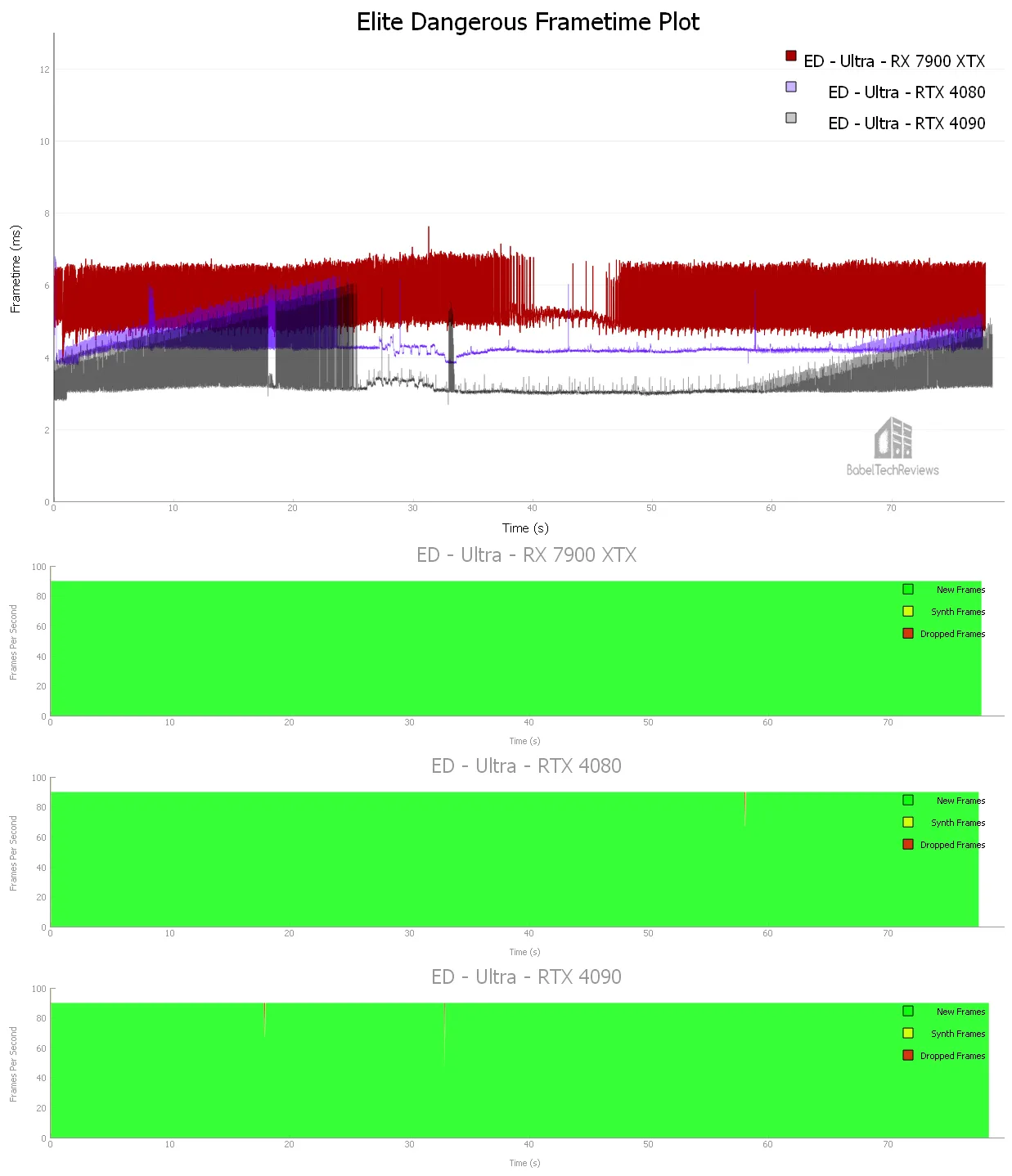
Here are the details as reported by FCAT-VR:
The RX 7900 XTX managed 185.21 unconstrained FPS with no synthesized frames with no dropped frames or Warp misses.
The RTX 4080 delivered 230.98 unconstrained FPS with 1 synthesized frame and 1 dropped frame and 1 Warp miss.
The RTX 4090 brings 296.16 unconstrained FPS together with 2 synthetic frames but with 2 dropped frames and 2 Warp misses.
Although the Hellhound RX 7900 XTX has the lowest performance, the experience playing Elite Dangerous at Ultra settings is not perceptibly different on any tested video card. However, the RTX 4090 has a lot more performance headroom to increase the render resolution or to use a higher resolution headset like the Reverb G2 or the Vive Pro 2.
Let’s look at our newest VR sim, F1 2022.
F1 2022
Codemasters has captured the entire Formula 1 2021 season racing in F1 2022, and the VR immersion is good. The graphics are customizeable and solid, handling and physics are good, the AI is acceptable, the scenery is outstanding, and the experience ticks many of the necessary boxes for a racing sim.
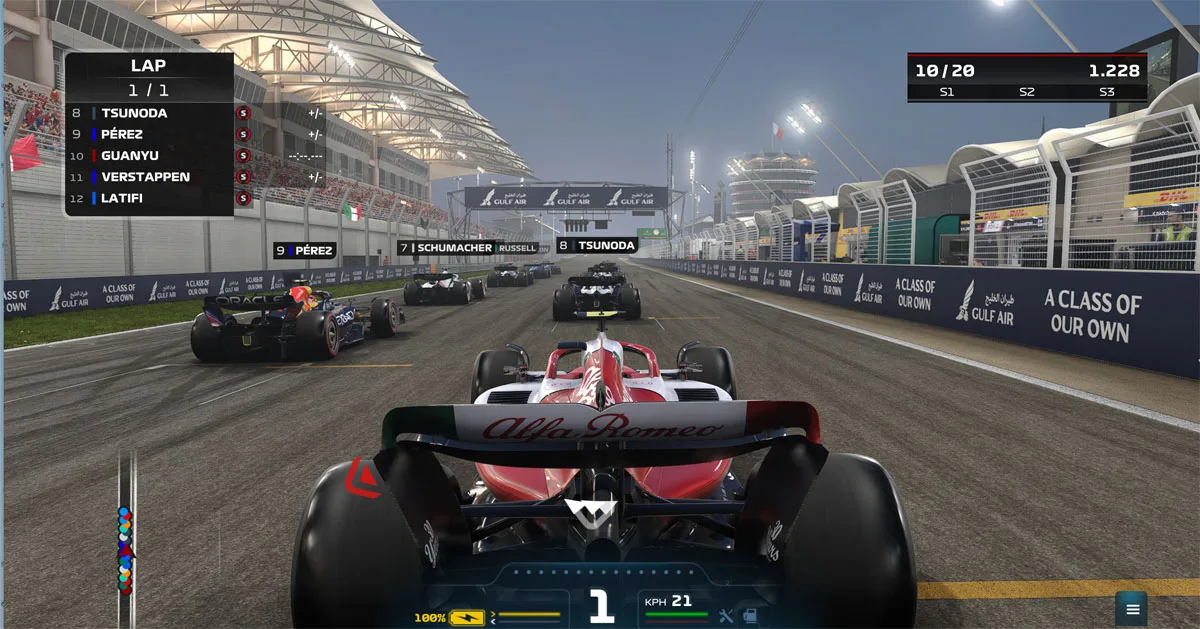
Here is the frametime plot for F1 2022.
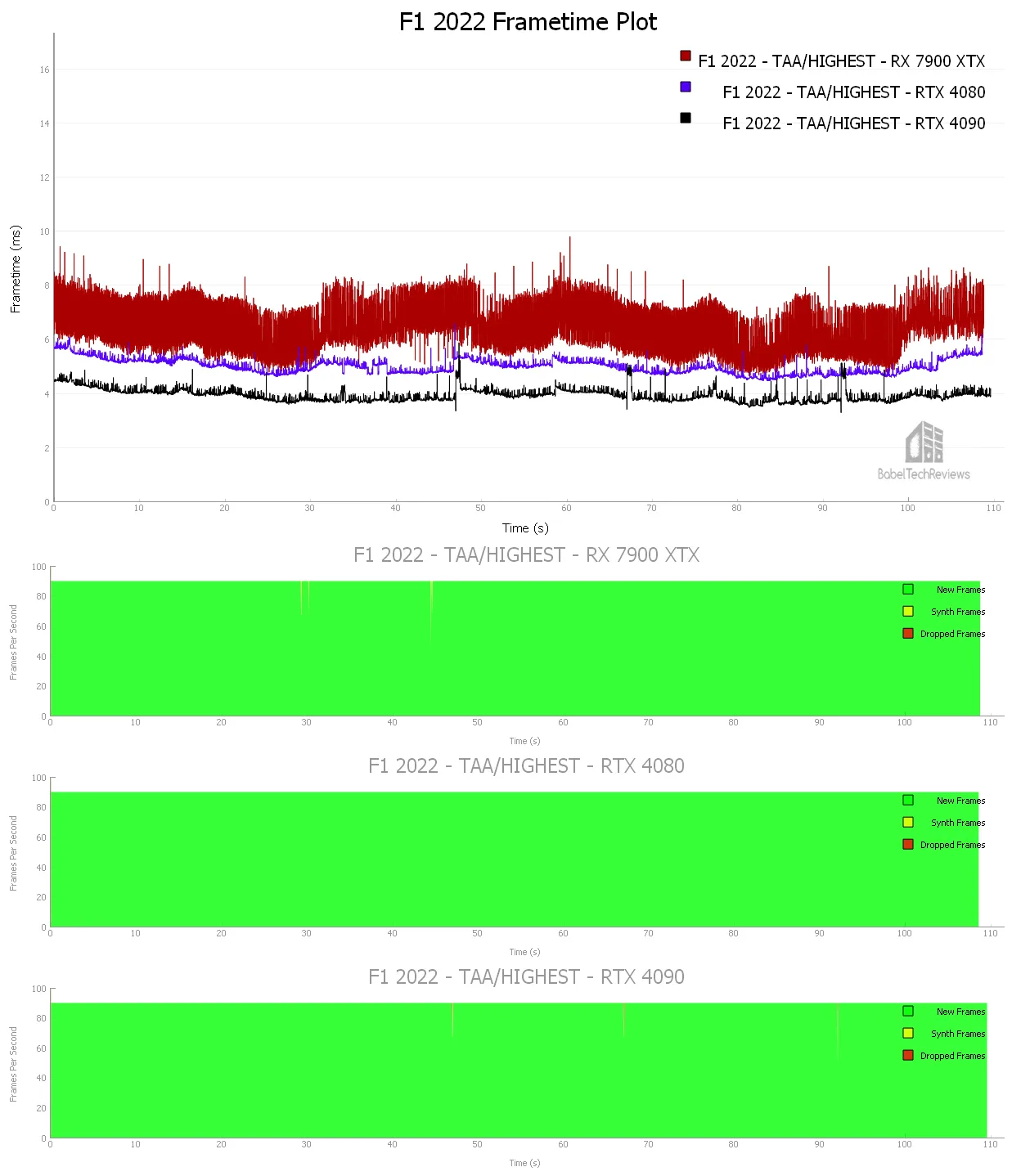
Here are the details as reported by FCAT-VR.
 The RX 7900 XTX delivered 156.57 unconstrained FPS with 6 synthesized but no dropped frames nor Warp misses.
The RX 7900 XTX delivered 156.57 unconstrained FPS with 6 synthesized but no dropped frames nor Warp misses.
The RTX 4080 achieved 200.24 unconstrained FPS with no synthesized or dropped frames nor Warp misses.
The RTX 4090 delivered 254.72 unconstrained FPS together with 3 synthetic frames plus with 3 dropped frames and 3 Warp misses.
The experience playing F1 2022 using the Ultra preset is not very different on any of these video cards but the RTX 4090 and RTX 4080 have considerably more performance headroom than the RX 7900 XTX to use 120Hz/144Hz or to use a higher resolution headset.
Kayak VR: Mirage
The outstanding near-photorealistic visual fidelity really sets Kayak VR: Mirage apart from other simulators. It boasts a wide range of locales with day/night/sunset options offering tropical, icy, desert, and even stormy scenarios with trips to Costa Rica, Antarctica, Norway, and Australia and occasional interactions with wildlife. It can be played as a relaxing sim or as a strenuous workout with competitive time trials which offer asynchronous multiplayer and ranking on global leaderboards.
We benchmark at 100% resolution with the highest “Cinematic” in-game settings but do not use DLSS or FSR.
Here is the frametime plot for Kayak VR: Mirage.

Here are the FCAT-VR details.

The RX 7900 XTX delivered 198.98 unconstrained FPS with no synthesized frames or dropped frames nor Warp misses.
The RTX 4080 delivered 257.16 unconstrained FPS with 1 synthesized and 1 dropped frame and 1 Warp miss.
The RTX 4090 got 329.35 unconstrained FPS together with 1 synthetic frame and 1 dropped frame plus 1 Warp miss.
Kayak VR: Mirage looks fantastic at 100% resolution with maximum settings and would be well-suited for play on the Reverb G2 with any of our test cards.
Next, we look at Moss: Book II.
Moss: Book II
Moss: Book II is an amazing VR experience with much better graphics than the original game. It’s a 3rd person puzzle adventure game played seated that offers a direct physical interaction between you (the Reader) and your avatar, Quill, a mouse that bring real depth to the story. Extreme attention has been paid to the tiniest details with overall great art composition and outstanding lighting that make this game a must-play for gamers of all ages.
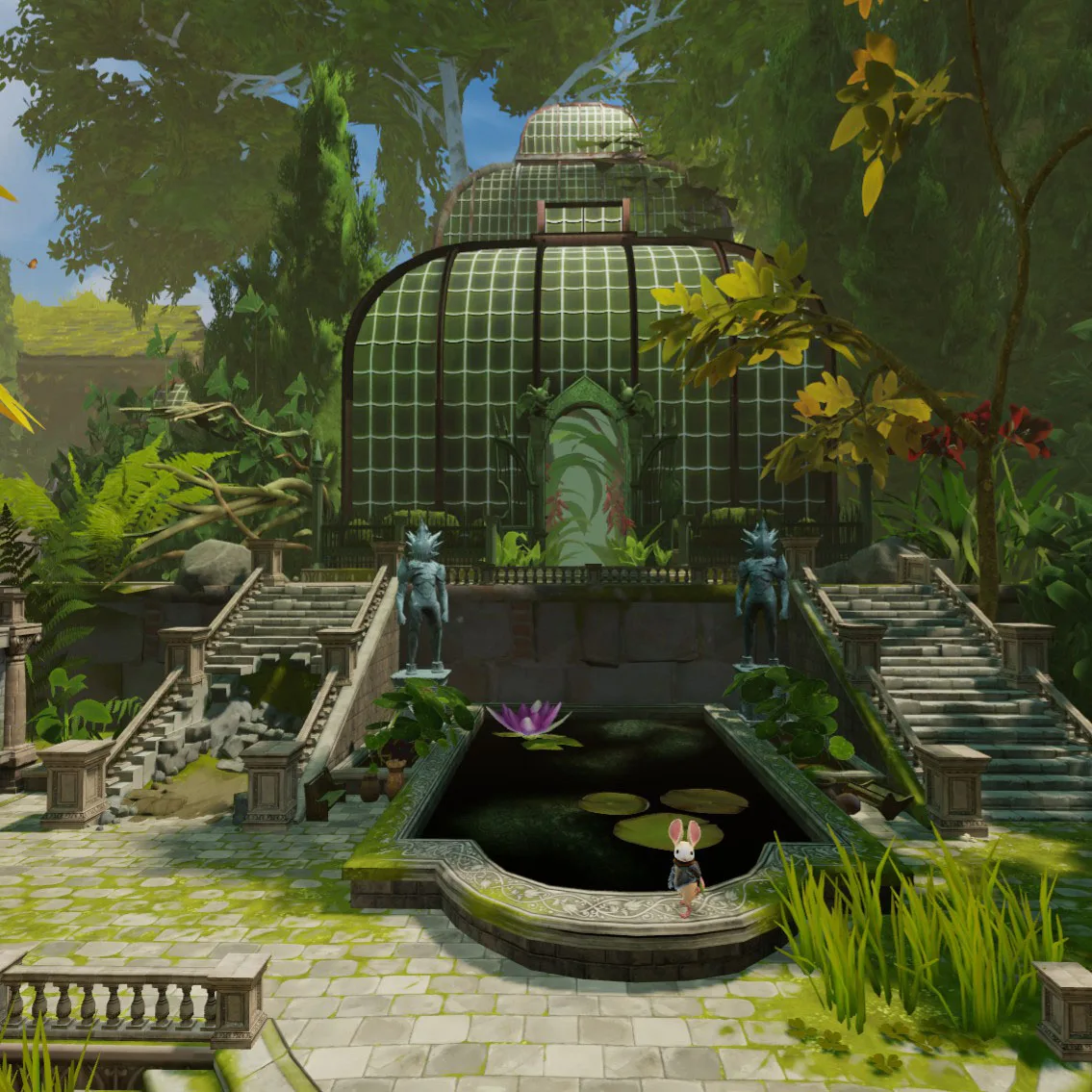
Moss II boasts very good visuals and we use the in-game highest settings.
Here are the frametimes plots of our four cards.
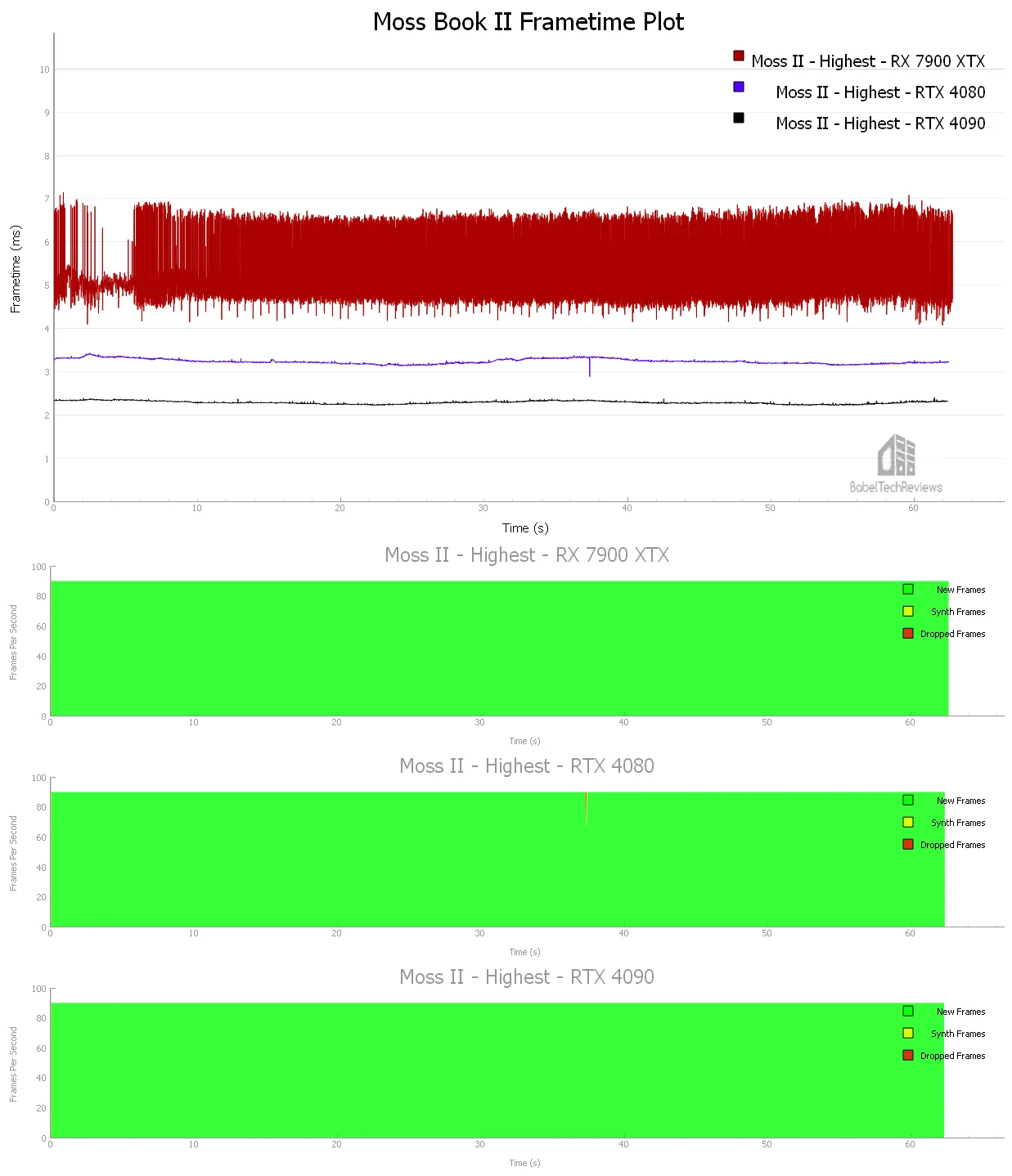
Here are the details are reported by FCAT-VR:

The RX 7900 XTX delivered 189.29 unconstrained FPS with no synthesized or dropped frames nor Warp misses.
The RTX 4080 delivered 308.44 unconstrained FPS with 1 synthetic and 1 dropped frame and 1 Warp miss.
The RTX 4090 achieved 436.34 unconstrained FPS no synthesized or dropped frames nor Warp misses.
Unfortunately, the experience playing Moss II on the Valve Index using the RX 7900 XTX is marred by visual issues including artifacting and shimmering.
Next, we will check out another demanding VR game, No Man’s Sky.
No Man’s Sky (NMS)
No Man’s Sky is an action-adventure survival single and multiplayer game that emphasizes survival, exploration, fighting, and trading. It is set in a procedurally generated deterministic open universe, which includes over 18 quintillion unique planets using its own custom game engine.
The player takes the role of a Traveller in an uncharted universe by starting on a random planet with a damaged spacecraft equipped with only a jetpack-equipped exosuit and a versatile multi-tool that can also be used for defense. The player is encouraged to find resources to repair his spacecraft allowing for intra- and inter-planetary travel, and to interact with other players.
Here is the No Man’s Sky frametime plot. We set the settings to Maximum which is a step over Ultra including setting the anisotropic filtering to 16X and upgrading to FXAA. We did not use any upscaling method.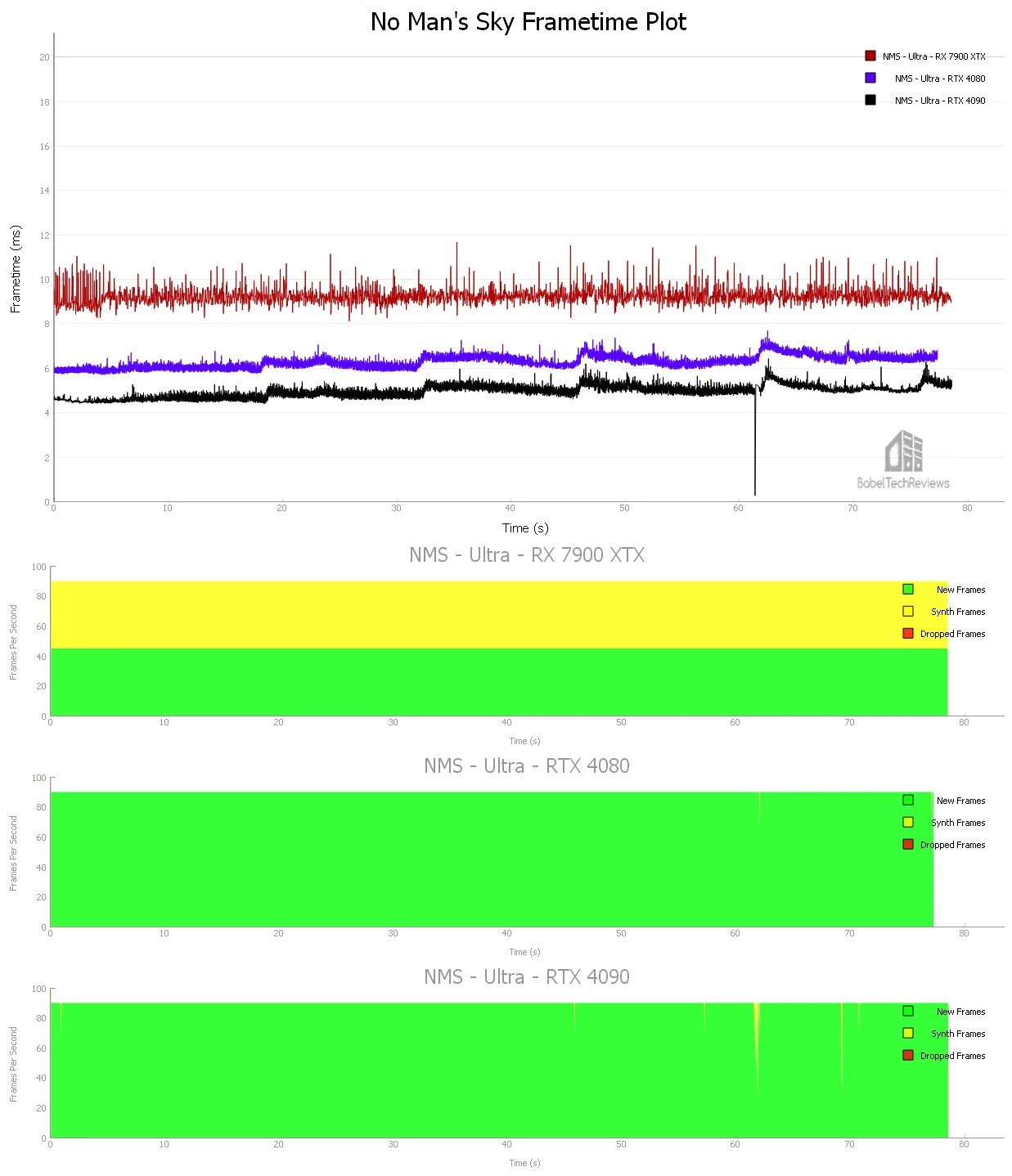
Here are the FCAT-VR details of our comparative runs.

The RX 7900 XTX brought 108.17 unconstrained FPS with 3536 (50%) synthesized frames but no dropped frames nor Warp misses.
The RTX 4080 delivered 159.10 unconstrained FPS with 2 synthesized frames but with no dropped frames nor Warp misses.
The RTX 4090 achieved 201.96 unconstrained FPS together with 17 synthetic frames but with no dropped frames nor Warp misses.
RX 7900 XTX gamers may want to lower some individual settings to remain above 90 FPS. The RTX 4080 and RTX 4090 have enough performance headroom to increase the refresh rate, render resolution, or to perhaps use a higher resolution headset.
Let’s continue with another VR game, Project CARS 2, that we still like better than its successor even though it is no longer available for online play.
Project CARS 2 (PC2)
There is still a sense of immersion that comes from playing Project CARS 2 in VR using a wheel and pedals. It uses its in-house Madness engine, and the physics implementation is outstanding. 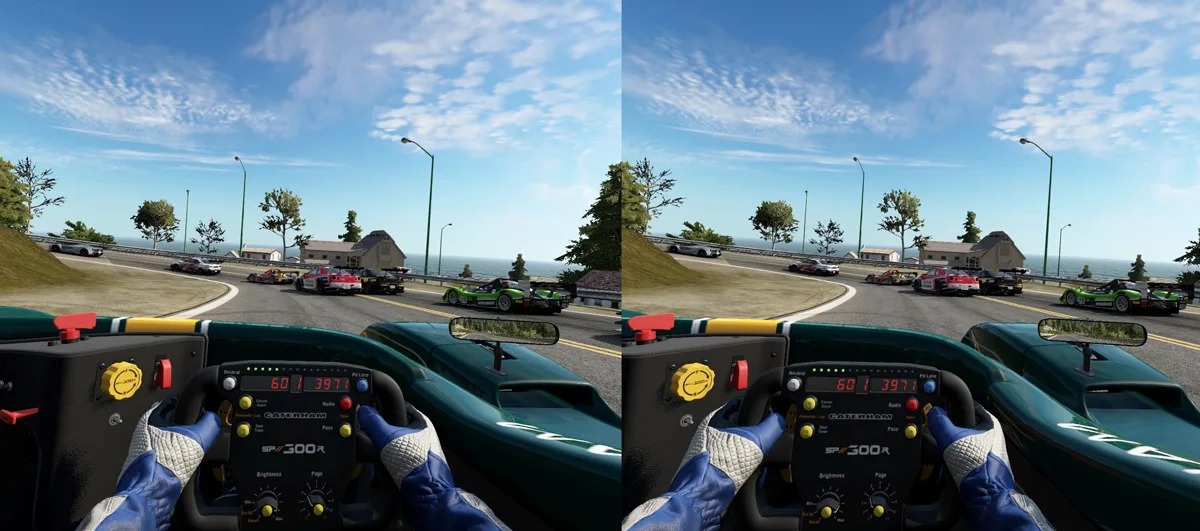
Project CARS 2 offers many performance options and settings.
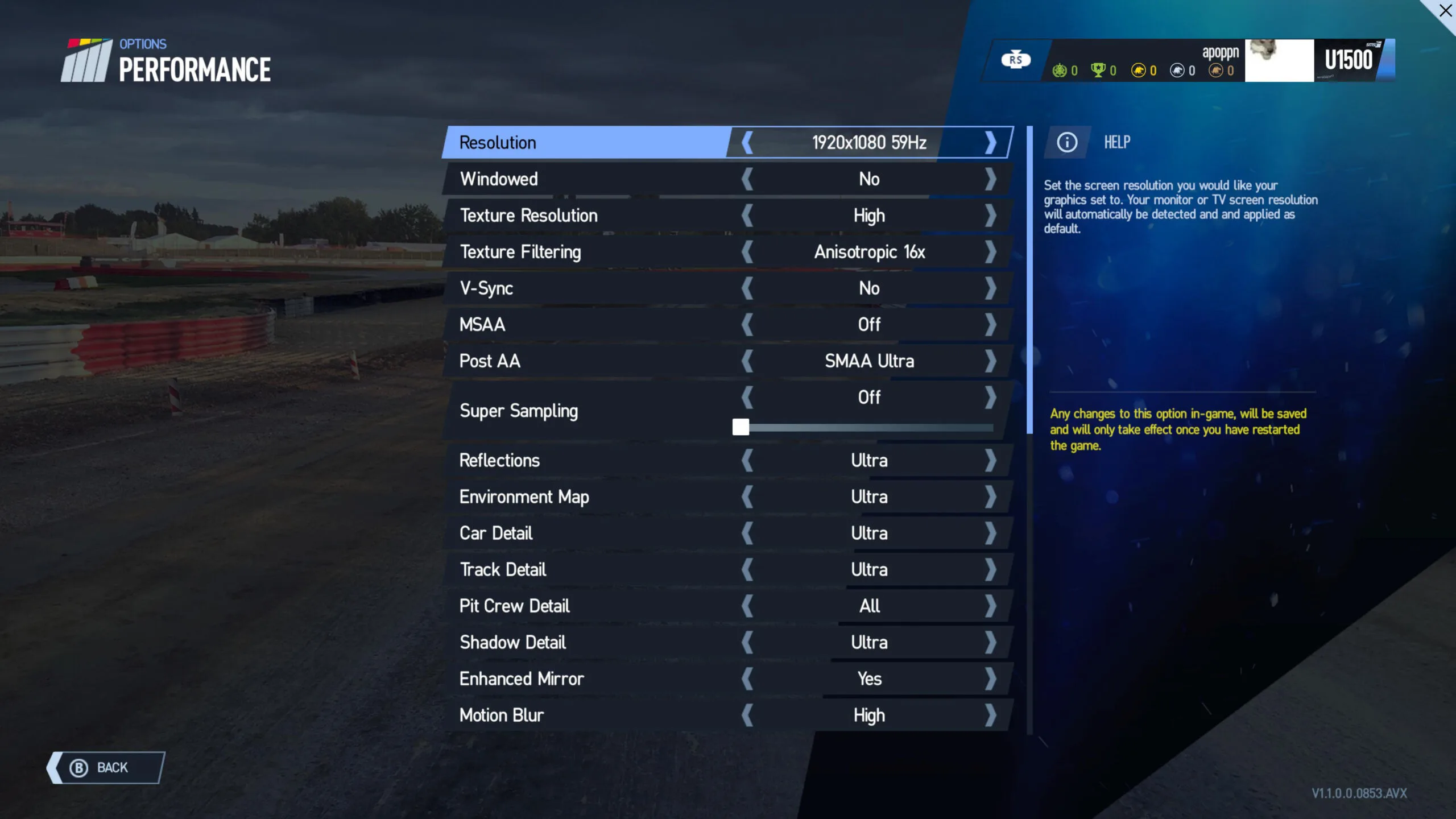
We used maximum settings including for Motion Blur but picked SMAA Ultra instead of MSAA.
Here is the frametime plot.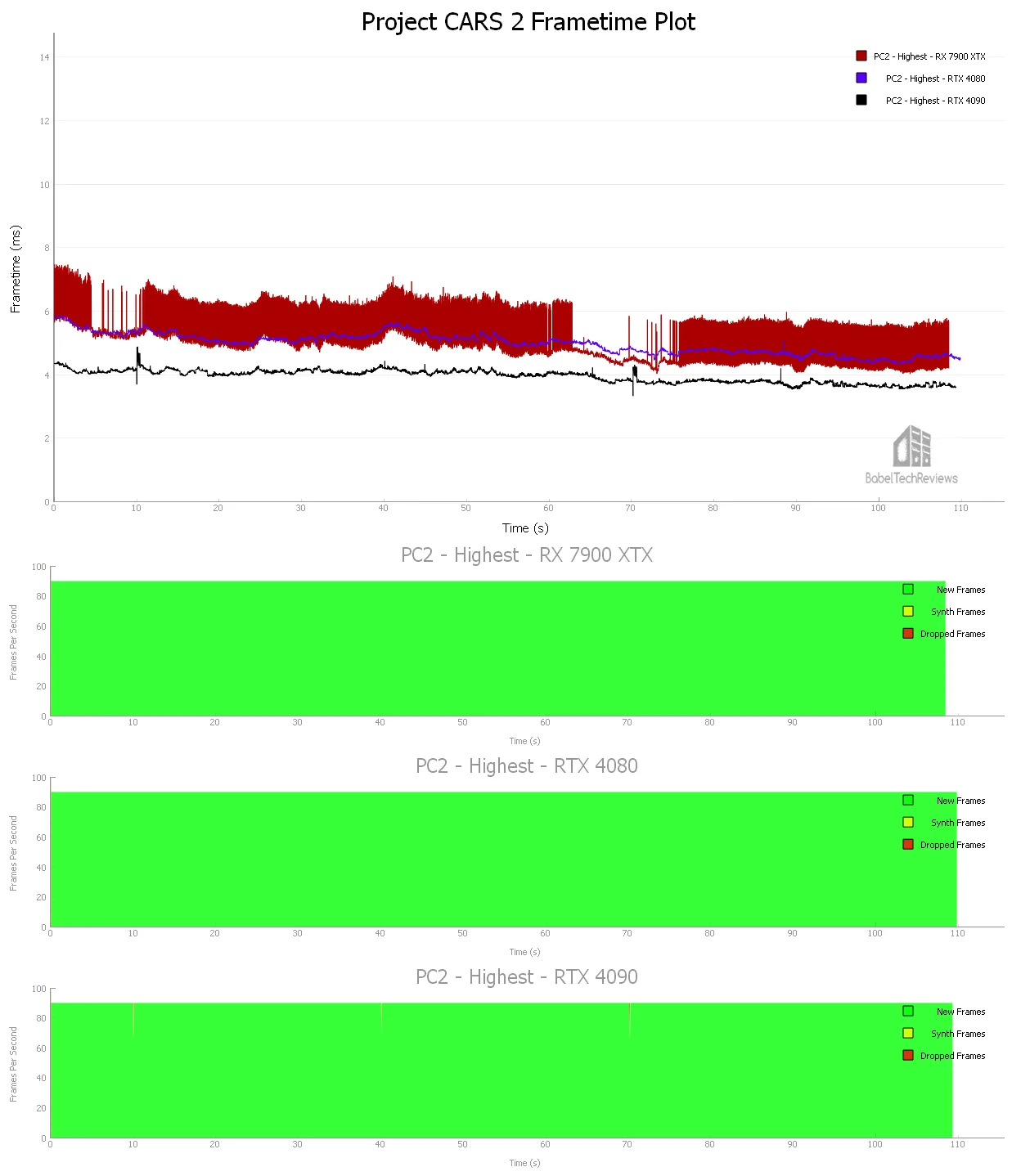
Here are the FCAT-VR details.

The RX 7900 XTX delivered 194.77 unconstrained FPS with no synthesized nor dropped frames or Warp misses.
The RTX 4080 got 200.88 unconstrained FPS with no synthesized frames nor dropped frames and no Warp misses.
The RTX 4090 achieved 253.50 unconstrained FPS together with 3 synthetic frames plus 2 dropped frames and 2 Warp misses.
The experience playing Project CARS 2 using maximum settings is similar for all three video cards.
Next we will check out a classic VR game, Skyrim VR.
Skyrim VR
Skyrim VR is an older game that is no longer supported by Bethesda, but fortunately the modding community has adopted it. It is not as demanding as many of the newer VR ports so its performance is still very good on maxed-out settings using its Creation engine.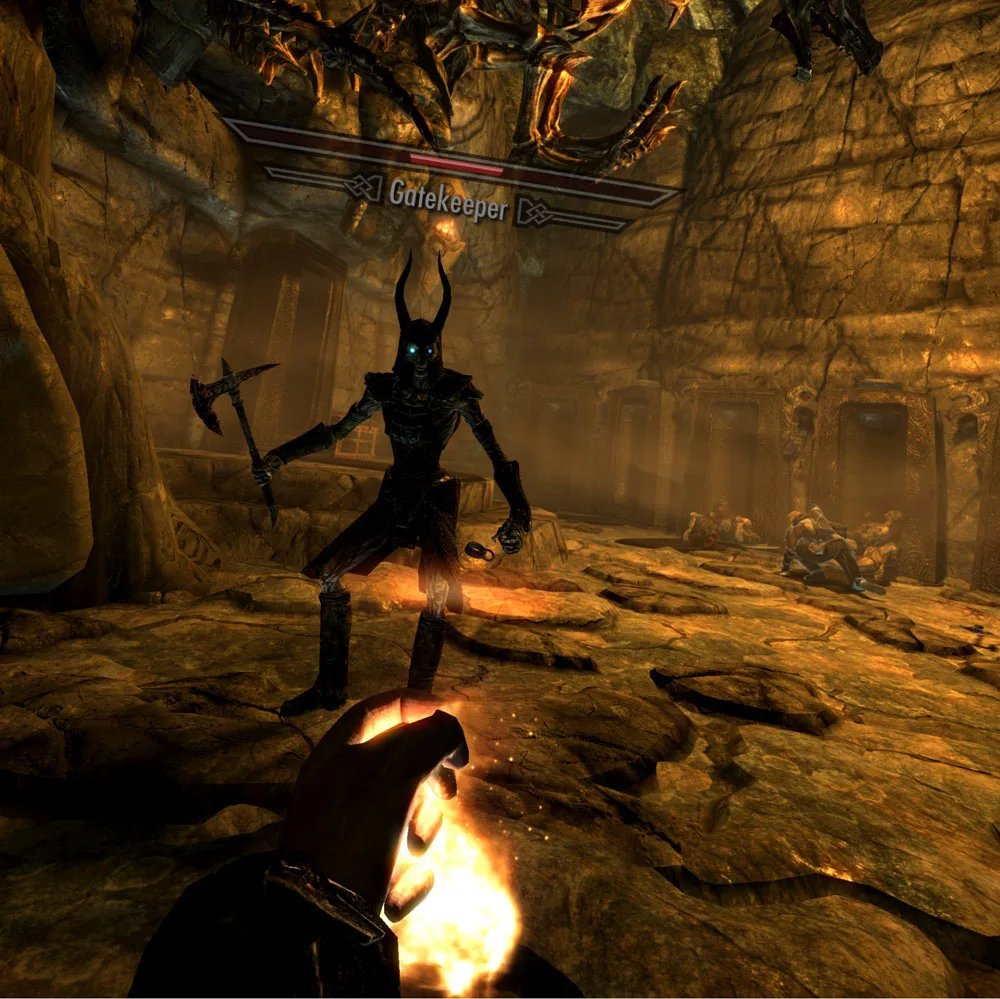
We benchmarked vanilla Skyrim using its highest settings plus we increased the in-game Supersample option to maximum.
Here are the frametime results.
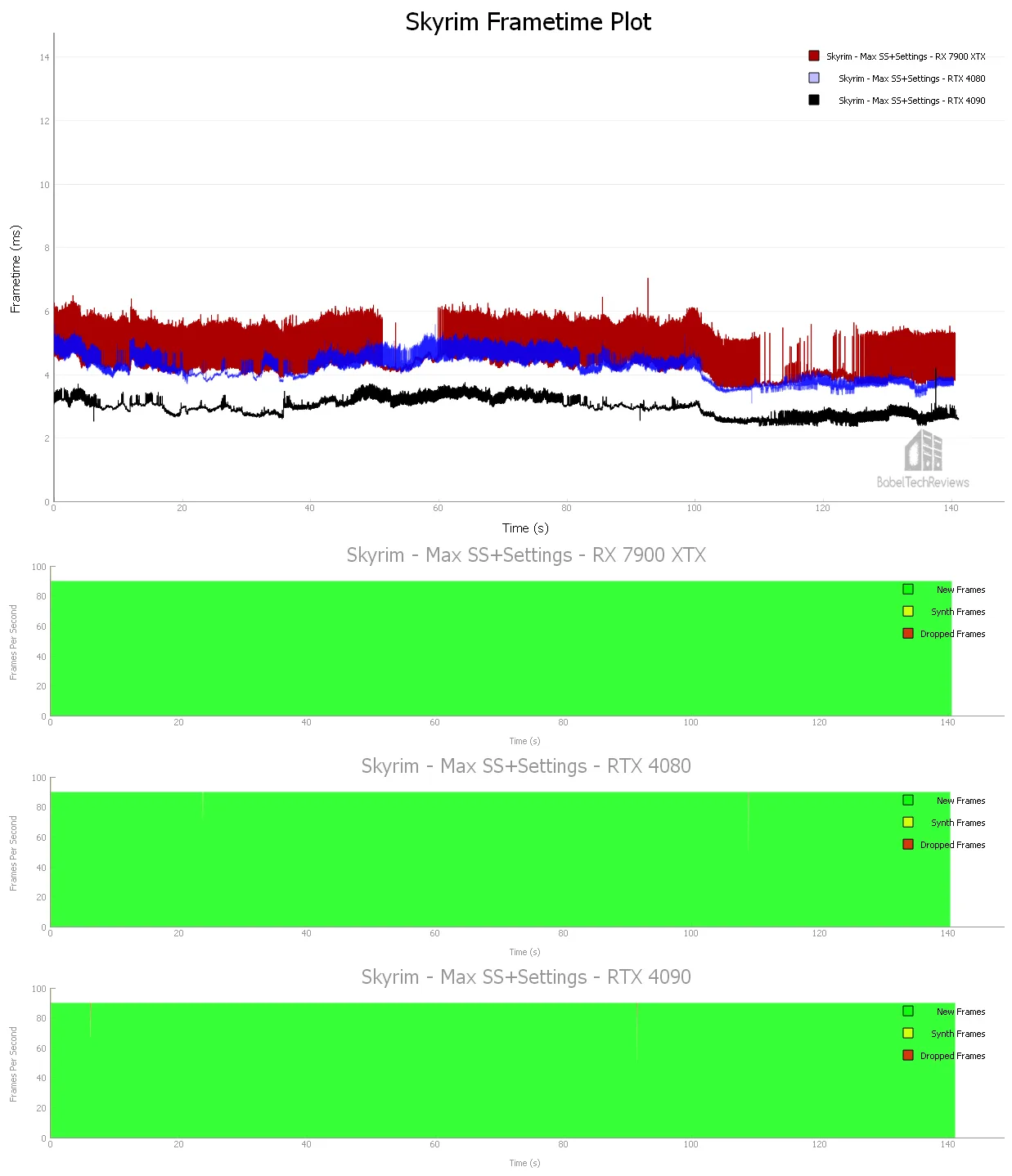 Here are the details of our comparative runs as reported by FCAT-VR.
Here are the details of our comparative runs as reported by FCAT-VR.

The RX 7900 XTX provided 218.2 unconstrained FPS with no synthesized or dropped frames nor Warp misses.
The RTX 4080 achieved 239.08 unconstrained FPS with 2 synthetic frames plus 2 dropped frames and 1 Warp miss.
The RTX 4090 delivered 337.76 unconstrained FPS together with 2 synthetic frame and with 2 dropped frames plus 1 Warp miss.
All cards deliver an identical vanilla Skyrim VR experience with a ton of extra performance headroom to add mods and, in addition, to raise the render resolution using the two faster cards.
Next we check out Sniper Elite VR.
Sniper Elite VR
Sniper Elite VR’s visuals are decent with good texture work that is well-realized. The building architecture and panoramas look good, explosions are convincing and the weapons convey a sense of weight, although not achieving realism. It is primarily an arcade style sniping game featuring its signature X-Ray kill cam, but it offers multiple ways to achieve goals including with explosives and by using three other main weapon choices besides your rifle.
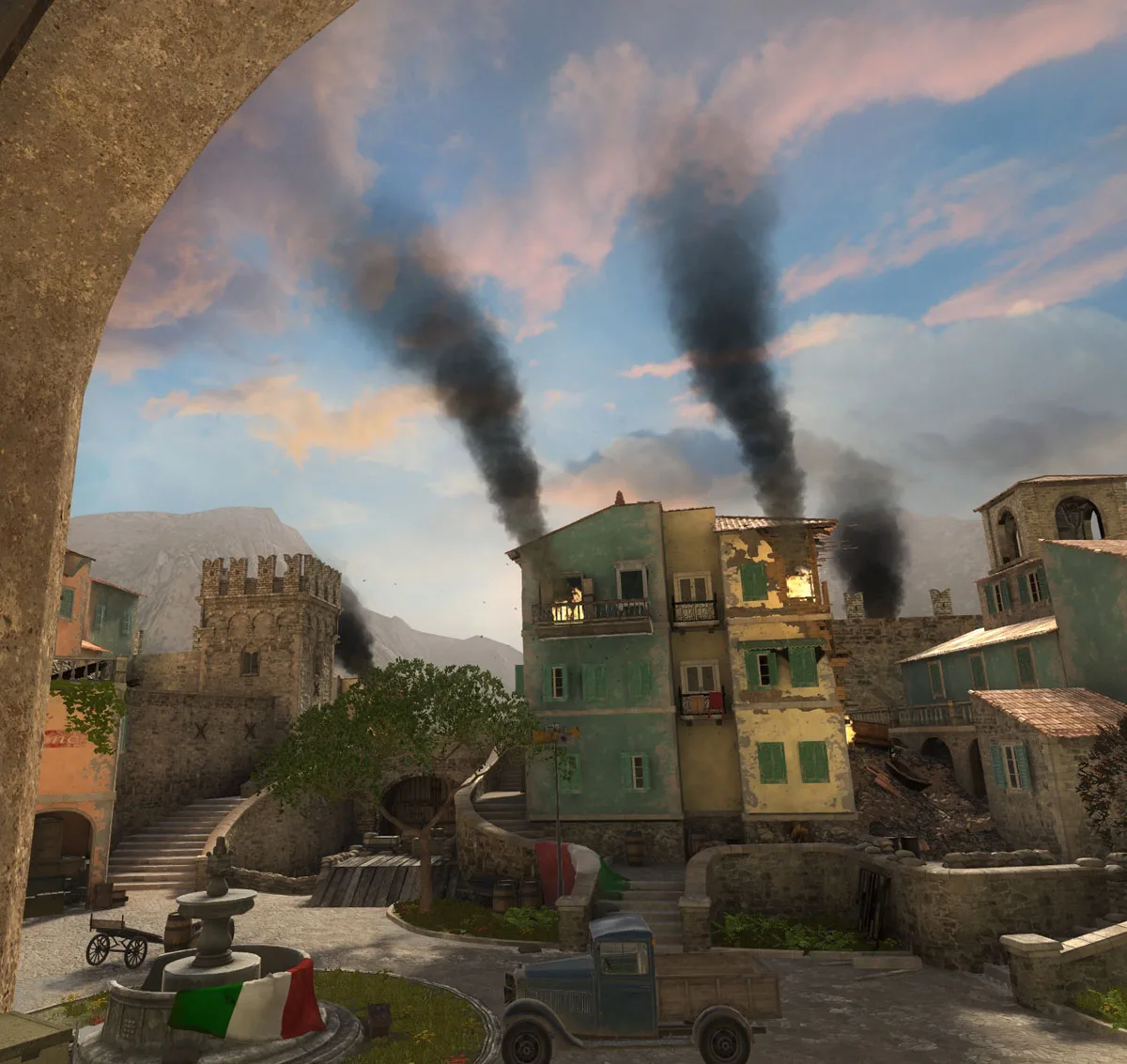
We benchmarked using the Highest settings.
Here is the frametime plot.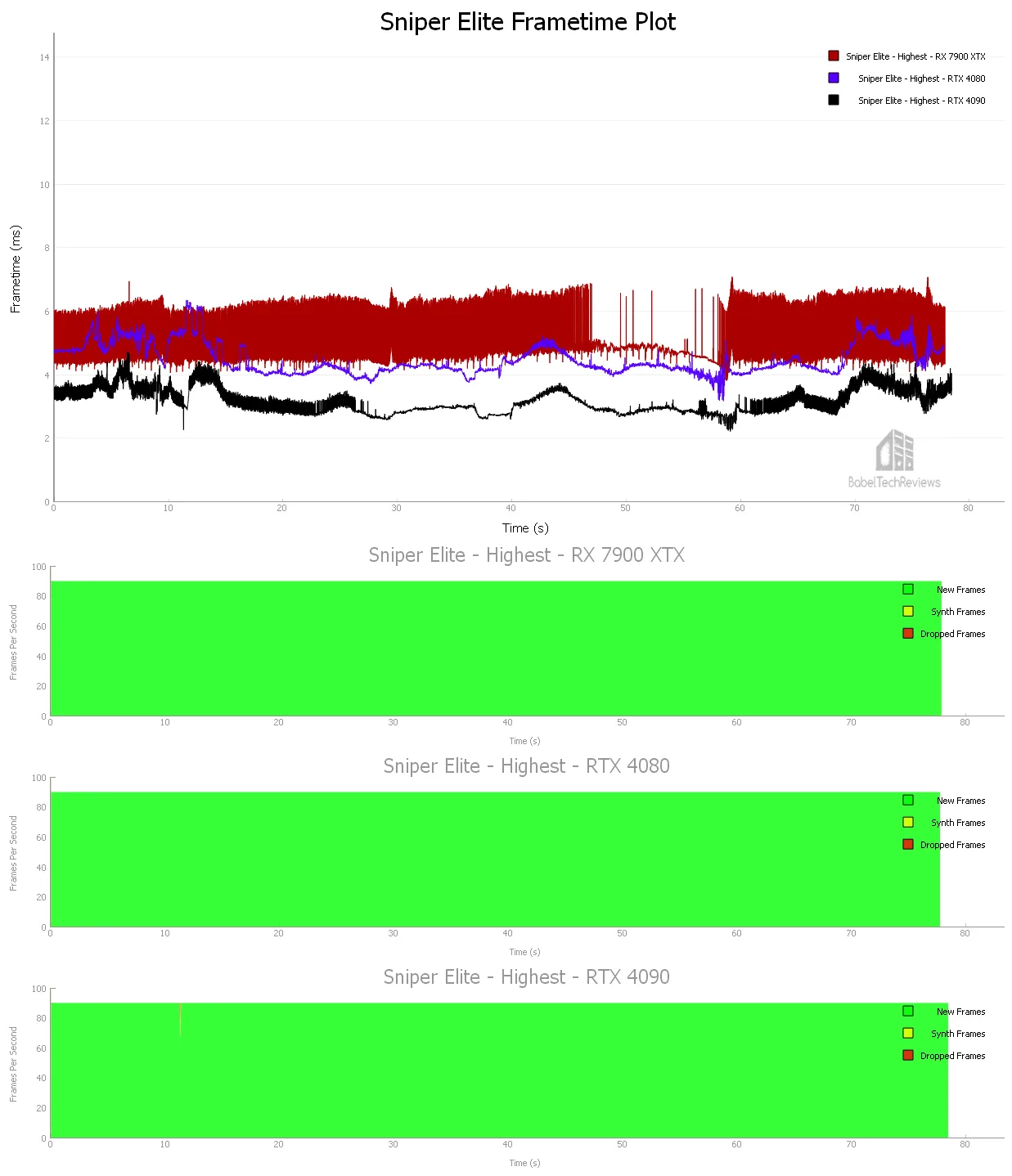
Here are the details:
The RX 6900 XT delivered 197.98 unconstrained FPS with no synthesized or dropped frames nor Warp misses.
The RTX 4080 delivered 223.33 unconstrained FPS with no synthesized or dropped frames nor Warp misses.
The RTX 4090 brought 318.03 unconstrained FPS together with 1 synthetic and 1 dropped frames and 1 Warp miss.
All three cards deliver a similar playing experience on High with the RTX cards offering more performance headroom. We recommend that any performance headroom be used for increasing the SteamVR render resolution.
Last up, The Walking Dead: Saints & Sinners.
The Walking Dead: Saints & Sinners
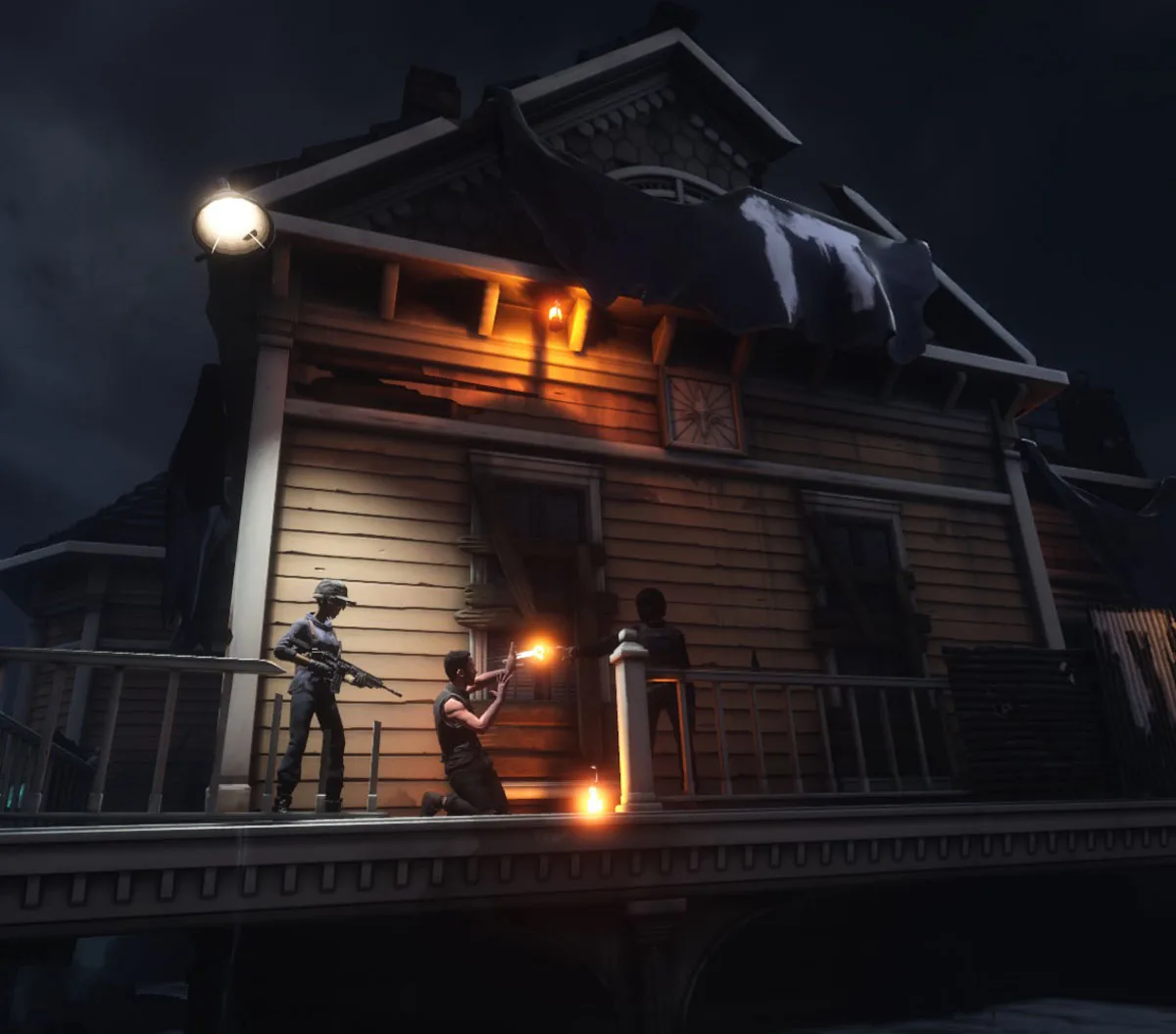
The Walking Dead: Saints & Sinner is the last of BTR’s 10 VR game benching suite. It is a first person survival horror adventure RPG with a strong emphasis on crafting. Its visuals using the Unreal 4 engine are very good and it makes good use of physics for interactions.
We benchmarked Saints and Sinners using its High preset and we left the Pixel Density at 100%. Here is the frametime chart.
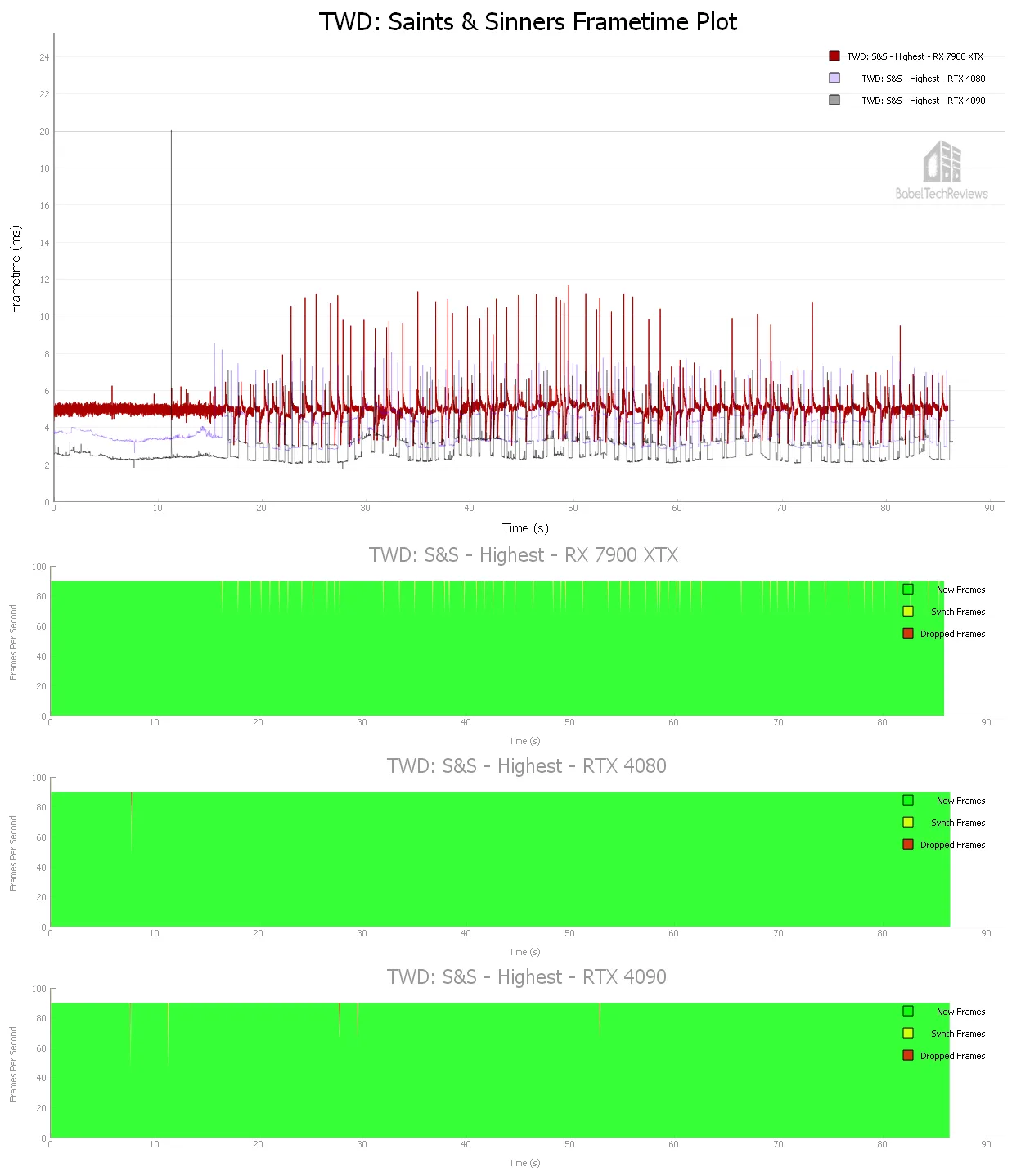
Here are the details as reported by FCAT-VR.
The RX 7900 XTX delivered 198.93 unconstrained FPS with no synthetic nor dropped frames or Warp misses.
The RTX 4080 got 260.94 unconstrained FPS with 1 synthetic frames and 1 dropped frames and 1 Warp miss.
The RTX 4090 achieved 366.41 unconstrained FPS together with 6 synthetic frames and with 4 dropped frames and 4 Warp misses.
The RX 7900 XTX experience was marred by artifacting and shimmering.
Let’s check out synthetic VR tests and unconstrained framerates.
Unconstrained Framerates & Synthetic VR Benchmarks
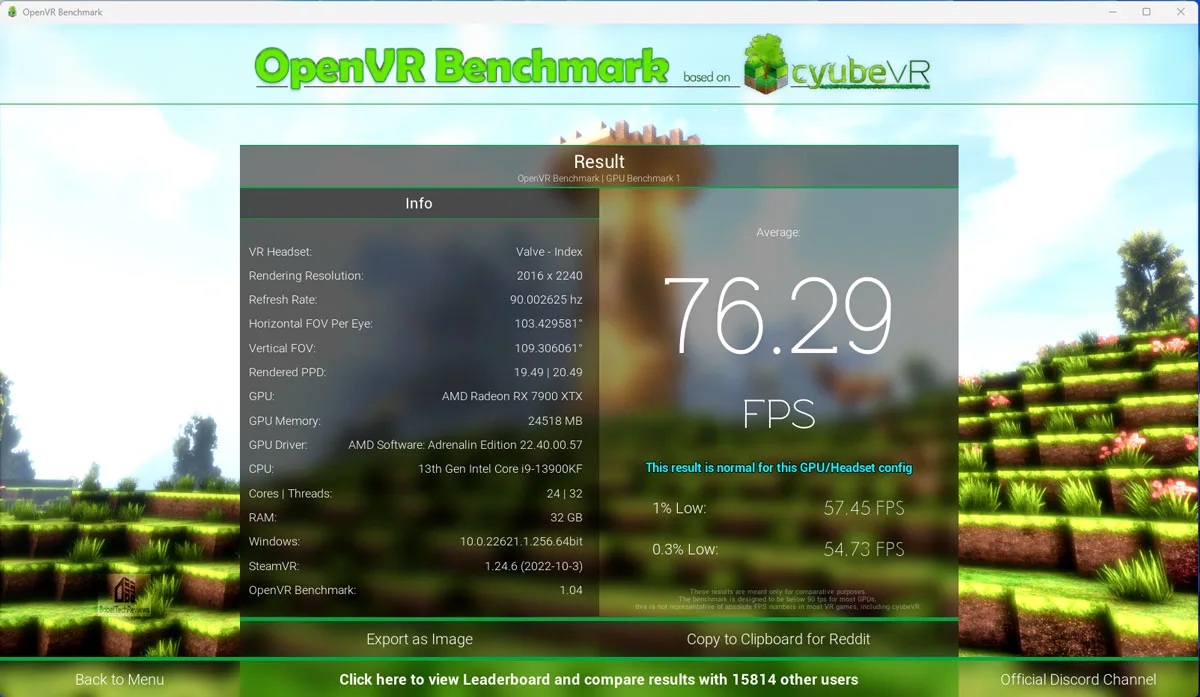
The following chart summarizes the overall Unconstrained Framerates (the performance headroom) of our three cards using our 10 VR test games. In addition, we added recent RTX 3080 Ti and 6900 XT results for comparison. The preset is listed on the chart and higher is better. In addition, we present three synthetic VR benchmarks.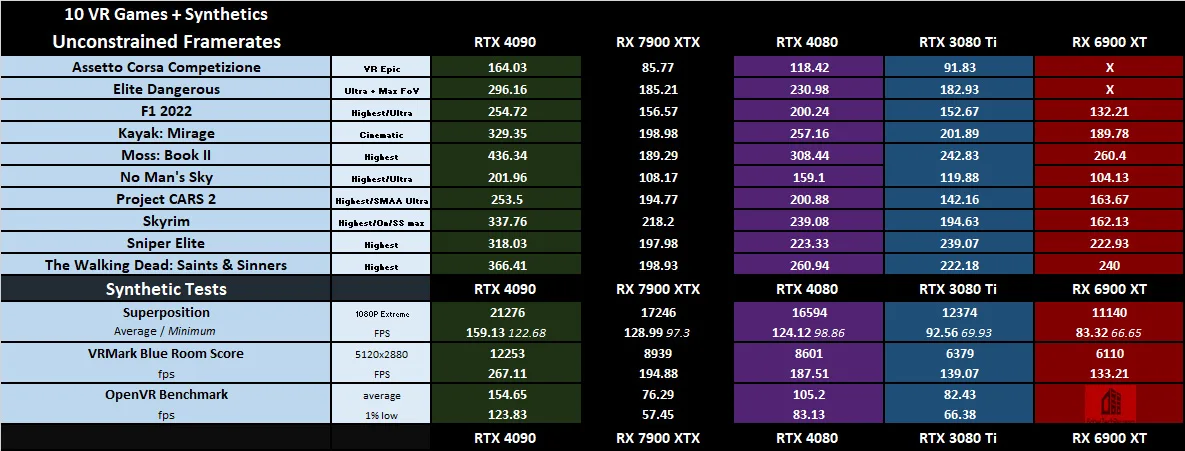
Although synthetic VR benches (except for OpenVR benchmark) predicted good VR performance, we were disappointed with our 7900 XTX VR experience, unlike with pancake games. In at least two games, we experienced distracting visual artifacting and texture shimmering. The 7900 series may benefit from some attention to VR from the Radeon driver team as in many cases it even falls behind the RX 6900 XT.
At AMD’s press event in Las Vegas, the presenters noted that AMD drivers continue to improve for the entire life of the architecture – generally with an up to 10% performance gain – often compared to “fine wine” aging well. However, for VR enthusiasts today, the RX 7900 XTX is disappointing and it performs well behind the RTX 4080 not logging a single performance win.
We next look at creative, pro, GPGPU, and workstation apps.
Creative, Pro & Workstation Apps
Let’s look at non-gaming applications next to see if the RX 7900 XTX is a good upgrade from the other video cards that we tested starting with Blender.
Blender 3.3.0 Benchmark
Blender is a very popular open source 3D content creation suite. It supports every aspect of 3D development with a complete range of tools for professional 3D creation.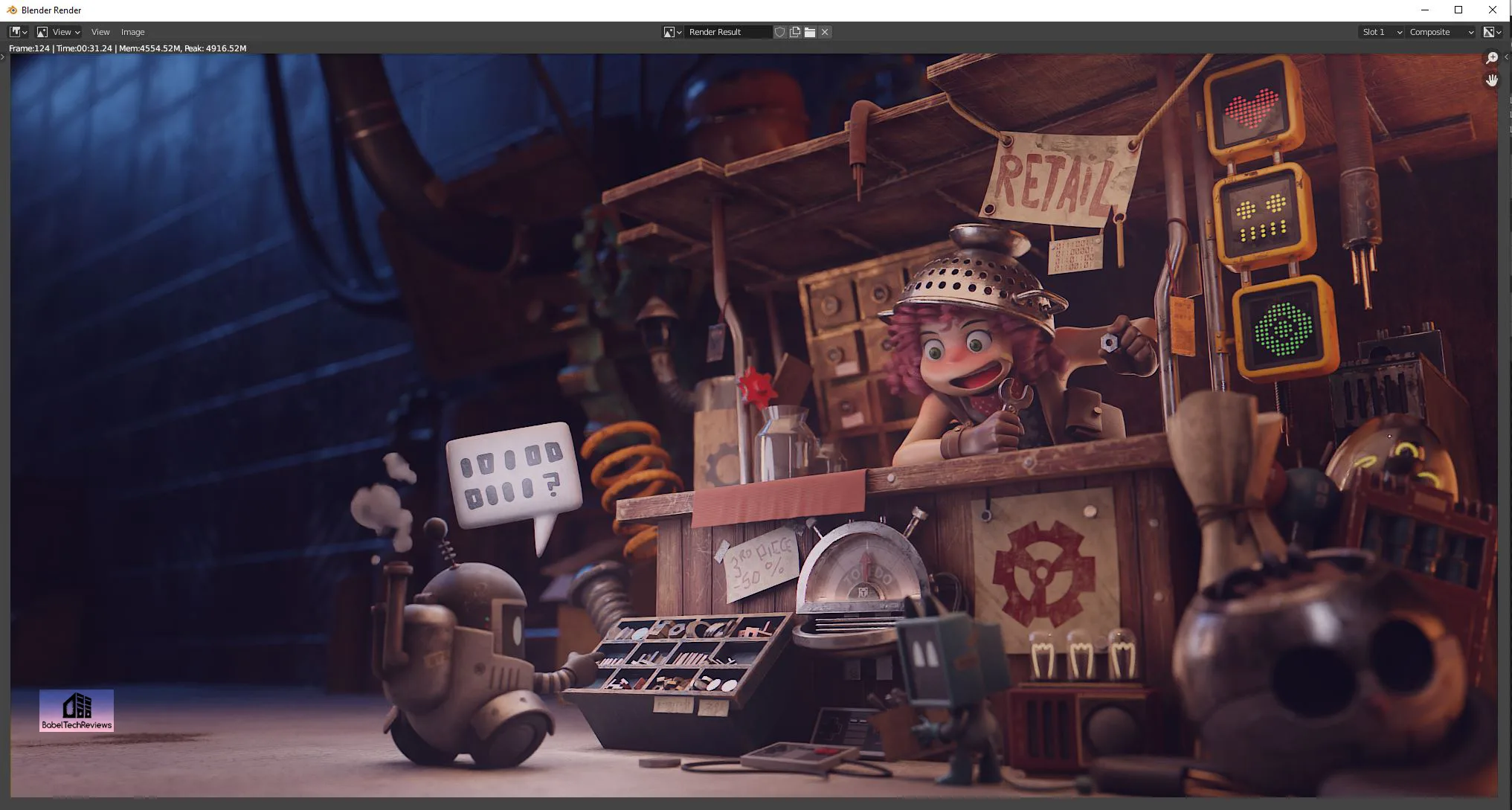
We benchmarked three Blender 3.3.0 benchmarks which measure GPU performance by timing how long it takes to render production files. We tested seven of our comparison cards using CUDA, Optix, and OpenCL.
For the following chart, higher is better as the benchmark renders a scene multiple times and gives the results in samples per minute.

The RX 7900 XTX sits well ahead of the RX 6800 XT and 6900 XT but well behind the GeForce cards.
Next, we move on to AIDA64 GPGPU benchmarks.
AIDA64 v6.80
AIDA64 is an important industry tool for benchmarkers. Its GPGPU benchmarks measure performance and give scores to compare against other popular video cards.
AIDA64’s benchmark code methods are written in Assembly language, and they are well-optimized for every popular AMD, Intel, NVIDIA and VIA processor by utilizing the appropriate instruction set extensions. We use the Engineer’s full version of AIDA64 courtesy of FinalWire. AIDA64 is free to to try and use for 30 days. CPU results are also shown for comparison with both the RTX 3070 and GTX 2080 Ti GPGPU benchmarks.
Here are the Hellhound RX 7900 XTX AIDA64 GPGPU results compared with an overclocked i9-13900KF.
Here is the chart summary of the AIDA64 GPGPU benchmarks with seven of our competing cards side-by-side.

The RX 7900 XTX is a fast GPGPU card and it compares favorably with the competing cards being weaker in some areas and stronger in others. So let’s look at Sandra 2020 next.
SiSoft Sandra 2020
To see where the CPU, GPU, and motherboard performance results differ, there is no better tool than SiSoft’s Sandra 2020. SiSoftware SANDRA (the System ANalyser, Diagnostic and Reporting Assistant) is a excellent information & diagnostic utility in a complete package. It is able to provide all the information about your hardware, software, and other devices for diagnosis and for benchmarking.
There are several versions of Sandra, including a free version of Sandra Lite that anyone can download and use. Sandra 2020 R10 is the latest version, and we are using the full engineer suite courtesy of SiSoft. Sandra 2020 features continuous multiple monthly incremental improvements over earlier versions of Sandra. It will benchmark and analyze all of the important PC subsystems and even rank your PC while giving recommendations for improvement.
We ran Sandra’s intensive GPGPU benchmarks and charted the results summarizing them.

In Sandra GPGPU benchmarks, since the architectures are different, each card exhibits different characteristics with different strengths and weaknesses. However, we see some very solid solid improvement of the RX 7900 XTX over the RX 6900 XT and the RX 6800 XT.
SPECworkstation3 (3.0.4) Benchmarks
All the SPECworkstation3 benchmarks are based on professional applications, most of which are in the CAD/CAM or media and entertainment fields. All of these benchmarks are free except for vendors of computer-related products and/or services.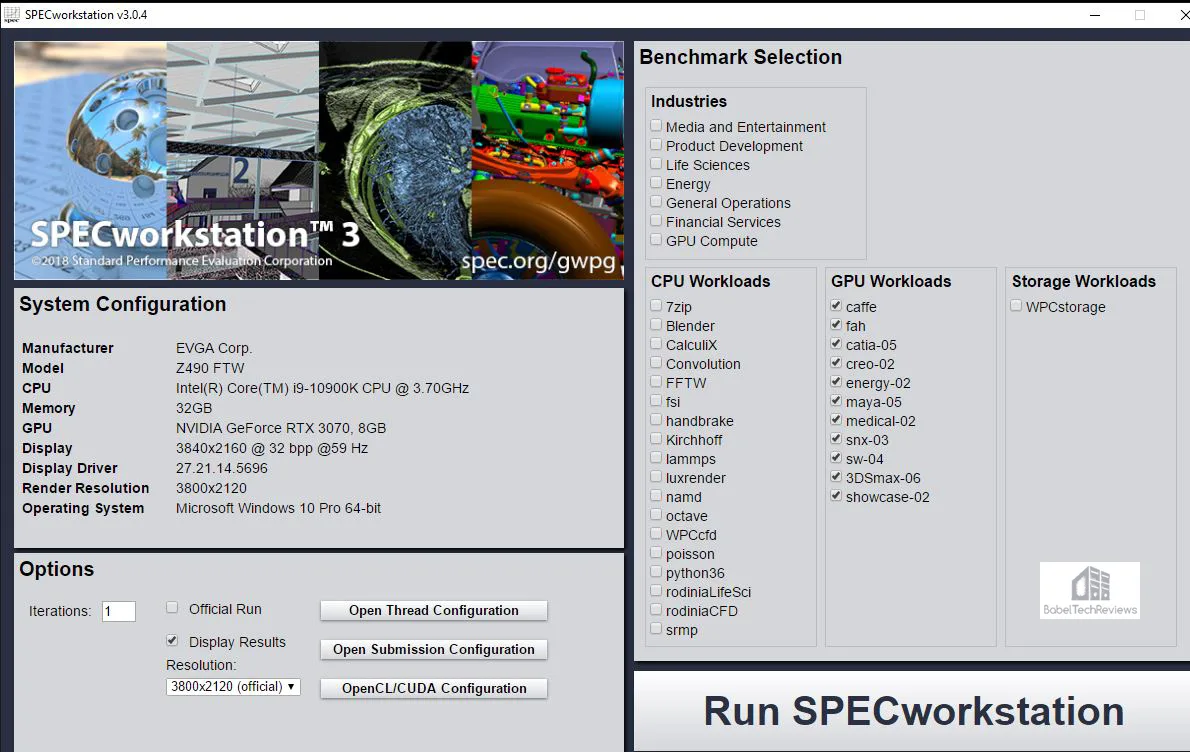
The most comprehensive workstation benchmark is SPECworkstation3. It’s a free-standing benchmark which does not require ancillary software. It measures GPU, CPU, storage and all other major aspects of workstation performance based on actual applications and representative workloads. We only tested the GPU-related workstation performance as checked in the image above.
Here are our SPECworkstation 3.0.4 raw scores for the Hellhound RX 7900 XTX. RTX 4080 raw scores are displayed below the XTX results for a detailed performance comparison.
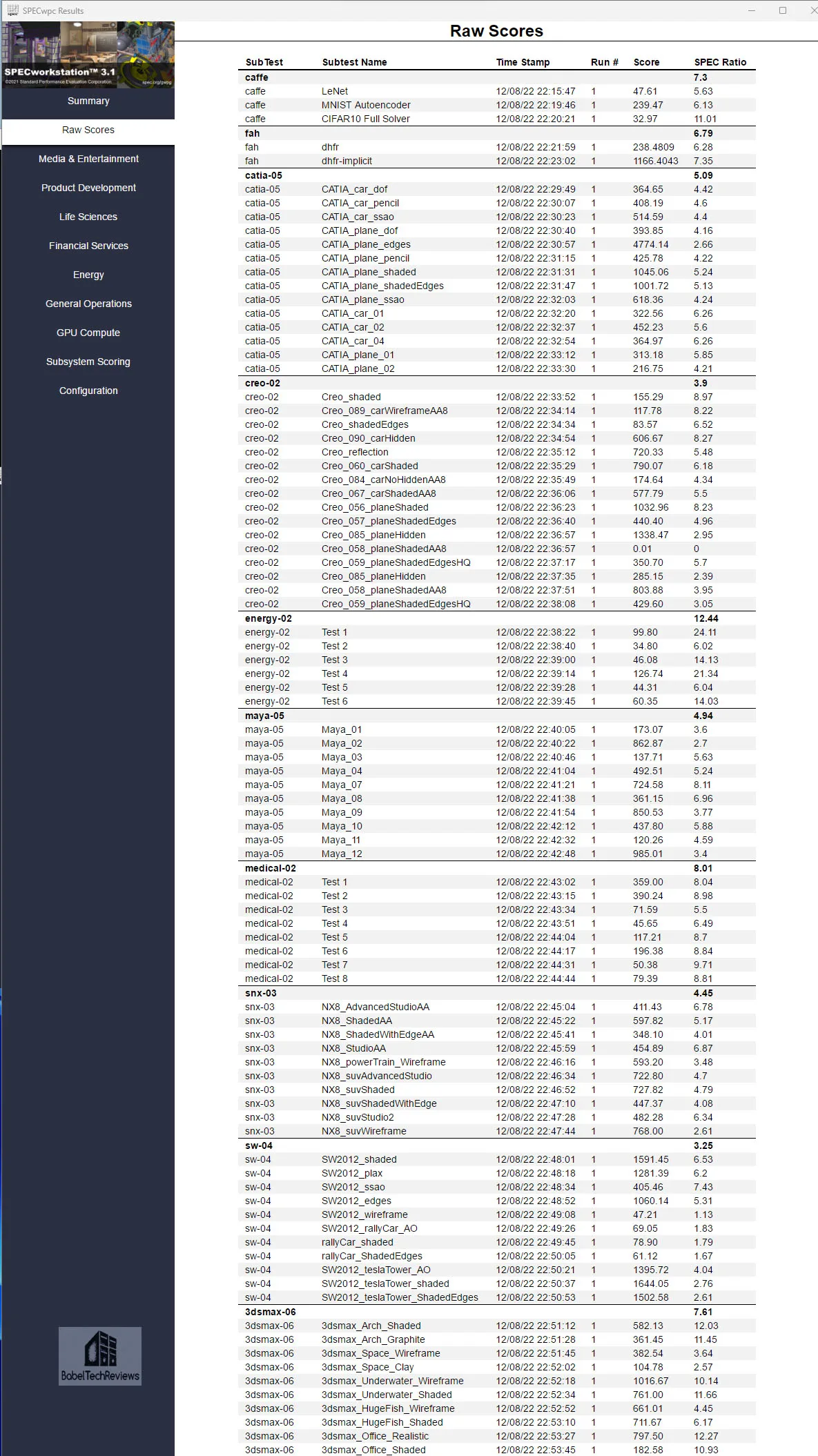

Here are our RTX 4080 SPECworkstation 3.1 raw scores: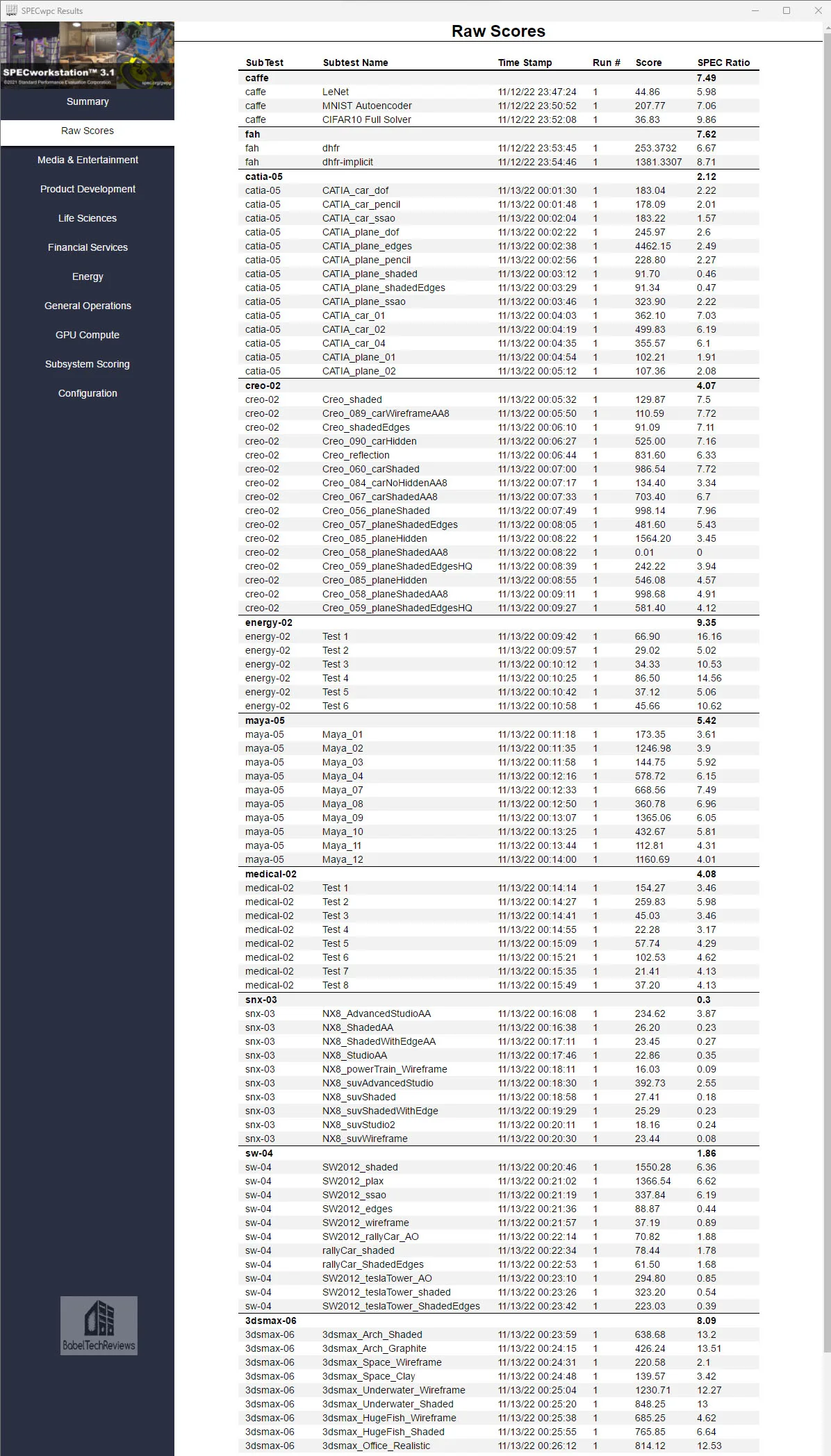

Here are the Hellhound XTX SPECworkstation3 results summarized in a chart along with six competing cards. Higher is better.
Using SPEC benchmarks, since the architectures are different, the cards each exhibit different characteristics with different strengths and weaknesses.
SPECviewperf 2020 GPU Benches
The SPEC Graphics Performance Characterization Group (SPECgpc) has released a new 2020 version of its SPECviewperf benchmark recently that features updated viewsets, new models, support for both 2K and 4K display resolutions, and improved set-up and results management.
We benchmarked at 4K and here are the summary results for the Hellhound RX 7900 XTX.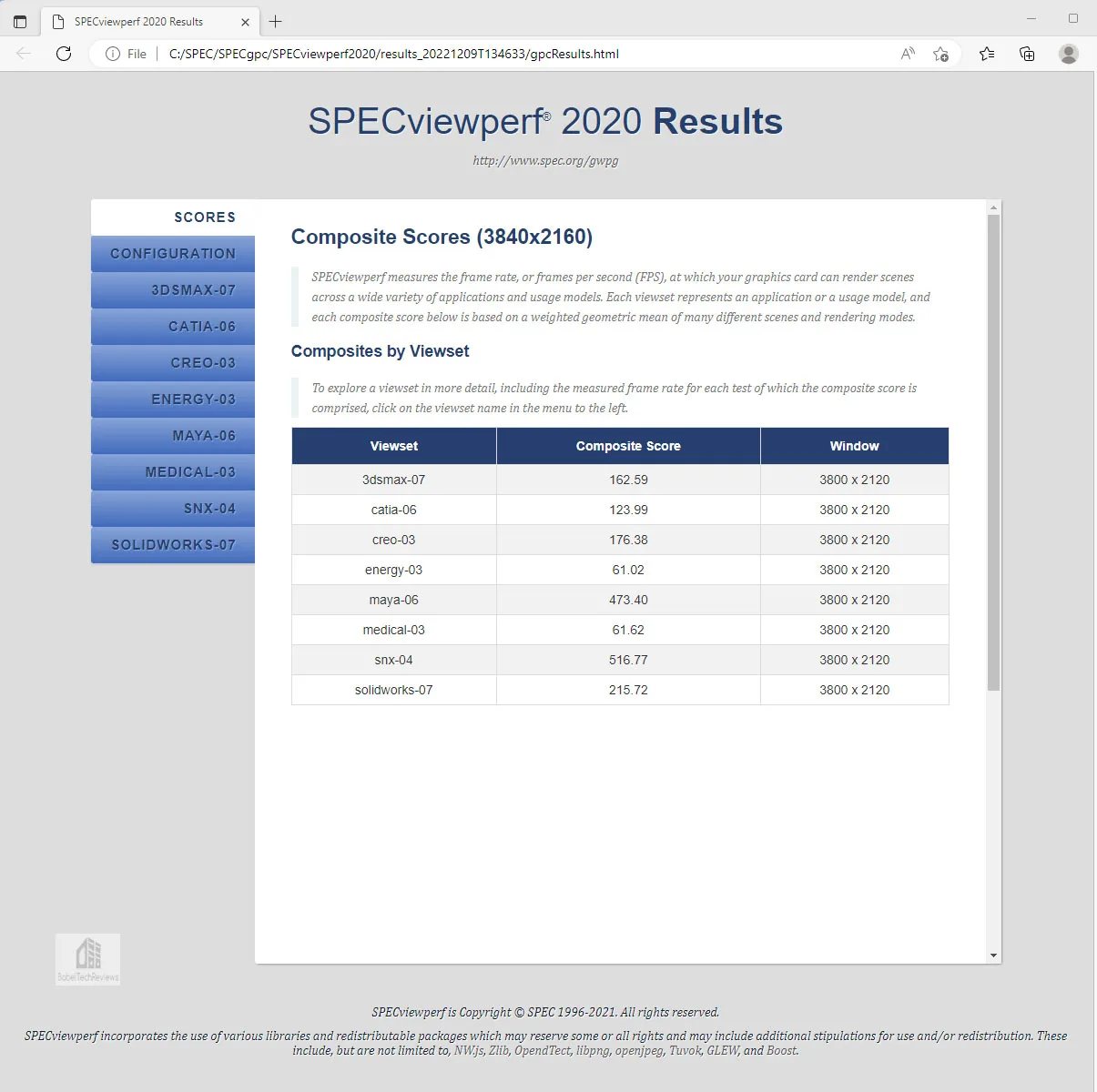
Here are SPECviewperf 2020 Hellhound RX 7900 XTX benchmarks summarized in a chart together with six other cards.

Again we see different architectures with different strengths and weaknesses. After seeing these benches, some creative users may upgrade their existing systems with a new card based on the performance increases and the associated increases in productivity that they require.
The question to buy a new video card should be based on the workflow and requirements of each user as well as their budget. Time is money depending on how these apps are used. However, the target demographic for the reference and Hellhound RX 7900 XTXs are primarily gaming for gamers.
Let’s head to our conclusion.
The Conclusion
The Hellhound RX 7900 XTX improves significantly over the last generation RX 6900 XT, easily exceeds RX 6800 XT performance, and it trades blows with the $200 more expensive RTX 4080 FE in rasterized games although overall it is slightly slower using our 42-game benching suite. The Hellhound RX 7900 XTX beats all of the last generation cards including the RTX 3080 Ti although it still struggles with ray traced games compared with RTX cards.
For Radeon gamers, the Hellhound RX 7900 XTX is a good alternative to GeForce Ada Lovelace cards for the vast majority of modern PC games that use rasterization. The RX 7900 XTX offers 24GB of GDDR6 to the 16GB of GDDR6X that the RTX 4080s are equipped with, but that 8GB of vRAM shouldn’t make any practical difference to game performance in the near future.
At its suggested price of $999, the Hellhound RX 7900 XTX costs about $200 less than the RTX 4080 FE and offers a good value for Radeon gamers. Unlike with the RTX 4080 which increased from $700 for the RTX 3080 to $1200, the RX 7900 XTX is priced the same $999 as AMD’s last generation RX 6900 XT. For Radeon buyers, what makes the Hellhound XTX particularly attractive is that there is no price premium for this mildly overclocked PowerColor card.
The only real issue that we see with Radeon 7000 series cards is that AMD’s FSR solution is still inferior to Nvidia’s DLSS AI upscaling that delivers similar performance but with better image quality. On the flip side, there are still relatively few ray traced games released every year in comparison to thousands of rasterized games where the RTX 7900 XTX trades blows with the much more expensive RTX 4080.
One major issue although affecting relatively few gamers is poor VR RX 7900 XTX performance compared with the RTX 4080. It’s going to need some attention from AMD’s driver team before we can recommend the RX 7900 XTX for the best VR gaming.
We recommend the Hellhound RX 7900 XTX as a great choice out of multiple good choices, especially for any AMD PC gamer looking for good looks with LED lighting, an exceptional cooler, great performance for 2560×1440 or 4K, PowerColor’s excellent support, and overall better value compared with the slower RX 7900 XTX reference version.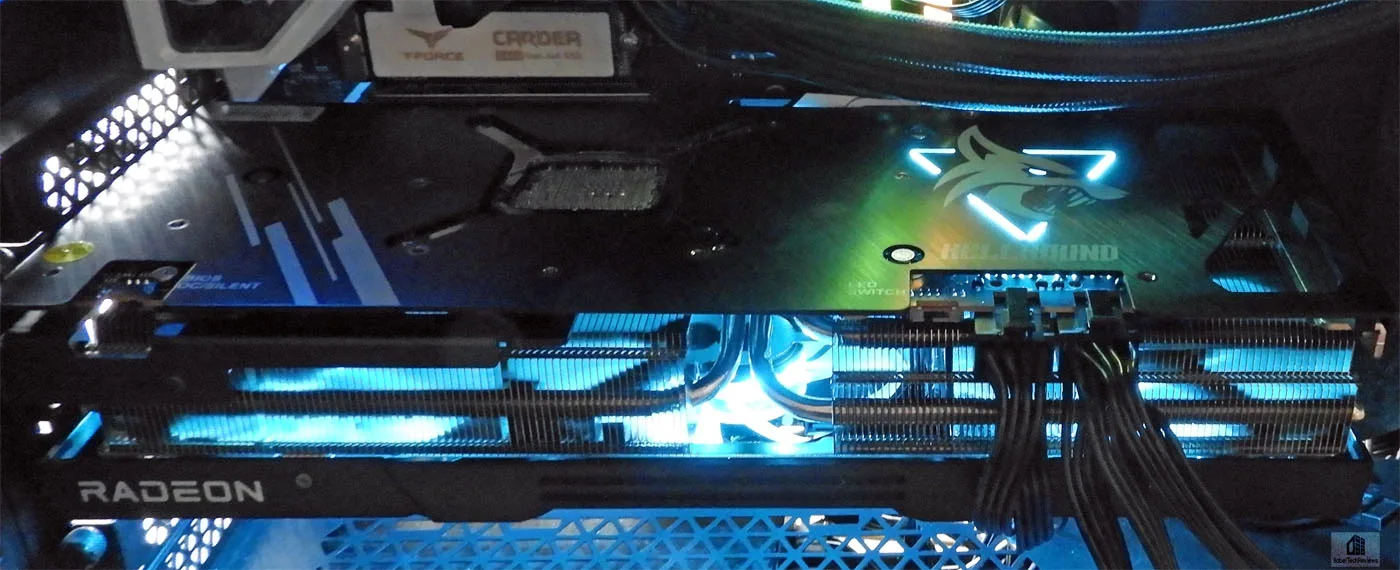
Let’s sum it up:
Hellhound RX 7900 XTX Pros
- The PowerColor Hellhound RX 7900 XTX is much faster than the last generation RX 6900 XT by virtue of new RDNA 3 architecture. It trades blows in the majority of rasterized games with the RTX 4080 FE for significantly less money ($200 less)
- The Hellhound RX 7900 XTX has excellent cooling with very little noise and has a very good power delivery and a 3-fan custom cooling design that is very quiet when overclocked even using the OC mode
- Dual-BIOS give the user a choice of quiet with less overclocking, or a bit louder with more power-unlimited and higher overclocks
- FidelityFX 2.0 allows for upscaling and improved sharpness with almost no performance penalty, and there is a low latency mode for competitive gamers
- LED lighting and a neutral color allow the Hellhound RX 7900 XTX to fit into any color scheme
- 24GB vRAM compared with 16GB for the RTX 4080
Hellhound XTX Cons
- Cost. It’s still very expensive at $999
- VR performance is subpar
- Weaker ray tracing performance than the RTX 4080
 The Hellhound RX 7900 XTX is a good Radeon card choice for those who game at 2560×1440 or at 4K and want the best that AMD has to offer. It represents a good gaming alternative to the RTX 4080 albeit with weaker ray tracing performance. It is offered especially for those who prefer AMD cards and FreeSync2 enabled displays which are generally less expensive than Gsync displays. And if a gamer is looking for something extra above the reference version, the PowerColor Hellhound RX 7900 XTX is a very well-made and good-looking card that will overclock better.
The Hellhound RX 7900 XTX is a good Radeon card choice for those who game at 2560×1440 or at 4K and want the best that AMD has to offer. It represents a good gaming alternative to the RTX 4080 albeit with weaker ray tracing performance. It is offered especially for those who prefer AMD cards and FreeSync2 enabled displays which are generally less expensive than Gsync displays. And if a gamer is looking for something extra above the reference version, the PowerColor Hellhound RX 7900 XTX is a very well-made and good-looking card that will overclock better.
We are giving the Hellhound RX 7900 XTX BTR’s Recommended Award.
The Verdict:
- PowerColor’s Hellhound RX 7900 XTX is a solidly-built handsome card with higher clocks out of the box than the same-priced reference version. It trades blows with the RTX 4080 in rasterized games. I t is a kick ass RX 7900 XTX.
Stay tuned, there is much more coming from BTR. We will soon return to VR with a mega performance evaluation to test the role of the CPU for VR performance. And we’ll retest the RX 7900 XTX using higher resolution headsets after AMD’s driver team has a chance to address it’s VR issues. We also plan to test Intel ARC video cards in VR.
Happy Gaming!
